HARRIS TR-389-A2 GSM Portable terminal User Manual exhibit 8
HARRIS CORPORATION GSM Portable terminal exhibit 8
HARRIS >
exhibit 8

Register your new phone, purchase Ericsson original accessories, and see the latest in products by visiting us at:
www.ericsson.com/us/consumer
6/00 PBM
This manual is published by Ericsson Inc., without any warranty. Improvements and changes to this manual necessitated by typographical
errors, inaccuracies of current information, or improvements to programs and/or equipment, may be made by Ericsson Inc., at anytime and
without notice. Such changes will, however, be incorporated into new editions of this manual.
"Ericsson", "Ericsson " and "ERICSSON ORIGINAL ACCESSORIES" are each registered U.S. Trademarks owned by Telefonaktiebolaget
LM Ericsson of Sweden.
“Tegic" and "T9" are each registered U.S. Trademarks owned by Tegic Communications, Inc. of Seattle, Washington, U.S.A. The T9® text
input product is provided under license from Tegic Communications Inc. and is covered by U.S. Pat. 5,818,437, U.S. Pat. 5,953,541, U.S.
Pat. 6,011,554 and other patents pending.
© 2000, Ericsson Inc. All rights reserved.
Publication Number: AE/LZT 123 5632 R1
Printed in USA
A2218z User’s Guide

Some menus/features are operator dependent.
i
Guidelines for Safe and Efficient Use . . . . . 1
Safety . . . . . . . . . . . . . . . . . . . . . . . . . . . . . . . . . . . . . . . . .1
Product Care and Operation . . . . . . . . . . . . . . . . . . . . . . .3
Battery Information . . . . . . . . . . . . . . . . . . . . . . . . . . . . . .4
FDA Consumer Update . . . . . . . . . . . . . . . . . . . . . . . . . .5
A2218z Features . . . . . . . . . . . . . . . . . . . . . 10
Getting Started. . . . . . . . . . . . . . . . . . . . . . . 13
Demonstration . . . . . . . . . . . . . . . . . . . . . . . . . . . . . . . .13
Assembling Your Phone . . . . . . . . . . . . . . . . . . . . . . . . . .13
Powering On Your Phone . . . . . . . . . . . . . . . . . . . . . . . .16
Display Language . . . . . . . . . . . . . . . . . . . . . . . . . . . . . .17
Display Icons . . . . . . . . . . . . . . . . . . . . . . . . . . . . . . . . . .17
Using Menus . . . . . . . . . . . . . . . . . . . . . . . . 19
Moving Through the Menus . . . . . . . . . . . . . . . . . . . . . .19
Menu System . . . . . . . . . . . . . . . . . . . . . . . . . . . . . . . . . .19
My Shortcuts . . . . . . . . . . . . . . . . . . . . . . . . . . . . . . . . . .20
Making and Receiving Calls . . . . . . . . . . . . 22
Making and Receiving Calls . . . . . . . . . . . . . . . . . . . . . .22
During a Call . . . . . . . . . . . . . . . . . . . . . . . . . . . . . . . . .23
Personalizing Your Phone . . . . . . . . . . . . . 25
Ring Signals . . . . . . . . . . . . . . . . . . . . . . . . . . . . . . . . . . 25
More Personalization Options . . . . . . . . . . . . . . . . . . . . 26
Profiles . . . . . . . . . . . . . . . . . . . . . . . . . . . . . . . . . . . . . . 28
Adding Accessories to a Profile . . . . . . . . . . . . . . . . . . . . 29
Your Phone Book . . . . . . . . . . . . . . . . . . . . 30
Memories . . . . . . . . . . . . . . . . . . . . . . . . . . . . . . . . . . . . 30
Creating a Phone Book Entry . . . . . . . . . . . . . . . . . . . . 30
Calling a Phone Book Entry . . . . . . . . . . . . . . . . . . . . . 31
Shortcuts to Phone Book Entries . . . . . . . . . . . . . . . . . . 31
Keeping the Phone Book Up to Date . . . . . . . . . . . . . . . 31
Copying Entries From One SIM to Another . . . . . . . . . 32
Checking the Status of the Memories . . . . . . . . . . . . . . . 32
When the SIM Card Memory Is Full . . . . . . . . . . . . . . . 32
Telephone Banking Services . . . . . . . . . . . . . . . . . . . . . . 33
Groups . . . . . . . . . . . . . . . . . . . . . . . . . . . . . . . . . . . . . . 33
E-mail Addresses . . . . . . . . . . . . . . . . . . . . . . . . . . . . . . 34
Entering Special Characters . . . . . . . . . . . . . . . . . . . . . . 34
Using the Call List . . . . . . . . . . . . . . . . . . . . . . . . . . . . . 35
Calling Cards . . . . . . . . . . . . . . . . . . . . . . . . . . . . . . . . . 36
Table of Contents
Some menus/features are operator dependent.
ii
Voicemail Service . . . . . . . . . . . . . . . . . . . . 39
Voicemail Notification . . . . . . . . . . . . . . . . . . . . . . . . . . 39
Storing your Voicemail number . . . . . . . . . . . . . . . . . . . 39
Calling Your Voicemail . . . . . . . . . . . . . . . . . . . . . . . . . . 39
Changing the Message Alert Signal . . . . . . . . . . . . . . . . . 39
Text Messaging (SMS). . . . . . . . . . . . . . . . . 41
Enabling Your Phone to Send SMS . . . . . . . . . . . . . . . . 41
Sending Text Messages . . . . . . . . . . . . . . . . . . . . . . . . . . 41
Customizing Your Text Messages . . . . . . . . . . . . . . . . . . 42
Templates for Text Messages . . . . . . . . . . . . . . . . . . . . . 42
Receiving a Text Message . . . . . . . . . . . . . . . . . . . . . . . . 43
Area Information . . . . . . . . . . . . . . . . . . . . . . . . . . . . . . 45
Cell Information . . . . . . . . . . . . . . . . . . . . . . . . . . . . . . . 46
Call Information . . . . . . . . . . . . . . . . . . . . . . 47
Total Call Time or Call Cost . . . . . . . . . . . . . . . . . . . . . 47
Determining the Call Cost . . . . . . . . . . . . . . . . . . . . . . . 47
Credit Limit for Calls . . . . . . . . . . . . . . . . . . . . . . . . . . . 48
Call Options . . . . . . . . . . . . . . . . . . . . . . . . . 49
Call Forwarding . . . . . . . . . . . . . . . . . . . . . . . . . . . . . . . 49
Restrict Calls . . . . . . . . . . . . . . . . . . . . . . . . . . . . . . . . . . 49
Fixed Dialing . . . . . . . . . . . . . . . . . . . . . . . . . . . . . . . . . 50
Closed User Groups . . . . . . . . . . . . . . . . . . . . . . . . . . . . 51
Accept Calls . . . . . . . . . . . . . . . . . . . . . . . . . . . . . . . . . . 51
Handling Multiple Calls. . . . . . . . . . . . . . . . 53
The Call Waiting Service . . . . . . . . . . . . . . . . . . . . . . . . 53
Receiving a Second Call . . . . . . . . . . . . . . . . . . . . . . . . . 53
Making a Second Call . . . . . . . . . . . . . . . . . . . . . . . . . . . 54
One Active Call and One Call On Hold . . . . . . . . . . . . . 54
Conference Calling . . . . . . . . . . . . . . . . . . . . . . . . . . . . . 54
Using Two Voice Lines . . . . . . . . . . . . . . . . . . . . . . . . . . 55
Voice Activation . . . . . . . . . . . . . . . . . . . . . 57
Voice Dialing . . . . . . . . . . . . . . . . . . . . . . . . . . . . . . . . . 57
Voice Answering . . . . . . . . . . . . . . . . . . . . . . . . . . . . . . . 58
Recording Problems . . . . . . . . . . . . . . . . . . . . . . . . . . . . 58
Calendar. . . . . . . . . . . . . . . . . . . . . . . . . . . . 59
Adding a Meeting . . . . . . . . . . . . . . . . . . . . . . . . . . . . . . 59
Adding a Phone Call . . . . . . . . . . . . . . . . . . . . . . . . . . . . 59
Adding a Reminder . . . . . . . . . . . . . . . . . . . . . . . . . . . . . 60
Using Your Calendar . . . . . . . . . . . . . . . . . . . . . . . . . . . . 60
Managing Your Calendar . . . . . . . . . . . . . . . . . . . . . . . . 61
Setting Network Preferences . . . . . . . . . . . 62
Forbidden Networks . . . . . . . . . . . . . . . . . . . . . . . . . . . . 62
List of Preferred Networks . . . . . . . . . . . . . . . . . . . . . . . 63
Search Modes . . . . . . . . . . . . . . . . . . . . . . . . . . . . . . . . . 63
Some menus/features are operator dependent.
iii
Security. . . . . . . . . . . . . . . . . . . . . . . . . . . . . 64
SIM Card Lock . . . . . . . . . . . . . . . . . . . . . . . . . . . . . . . .64
Phone Lock . . . . . . . . . . . . . . . . . . . . . . . . . . . . . . . . . . .64
Keypad Lock . . . . . . . . . . . . . . . . . . . . . . . . . . . . . . . . . .65
Extras . . . . . . . . . . . . . . . . . . . . . . . . . . . . . . 66
Alarm Clock . . . . . . . . . . . . . . . . . . . . . . . . . . . . . . . . . .66
Calculator . . . . . . . . . . . . . . . . . . . . . . . . . . . . . . . . . . . .66
Games . . . . . . . . . . . . . . . . . . . . . . . . . . . . . . . . . . . . . . .66
Timer . . . . . . . . . . . . . . . . . . . . . . . . . . . . . . . . . . . . . . .68
Stopwatch . . . . . . . . . . . . . . . . . . . . . . . . . . . . . . . . . . . .68
Online Services . . . . . . . . . . . . . . . . . . . . . . 70
Online Services . . . . . . . . . . . . . . . . . . . . . . . . . . . . . . . .70
New Menu . . . . . . . . . . . . . . . . . . . . . . . . . . . . . . . . . . .70
Proactive SIM . . . . . . . . . . . . . . . . . . . . . . . . . . . . . . . . .70
Data Download to the SIM Over the Air . . . . . . . . . . . .71
SIM Card Initiated Features . . . . . . . . . . . . . . . . . . . . . .71
Details of Services Offered . . . . . . . . . . . . . . . . . . . . . . . .71
Ericsson Mobile Internet . . . . . . . . . . . . . . . . . . . . . . . . .72
Using the WAP Browser . . . . . . . . . . . . . . . 73
Terminology . . . . . . . . . . . . . . . . . . . . . . . . . . . . . . . . . .73
Before You Start . . . . . . . . . . . . . . . . . . . . . . . . . . . . . . .73
Setting Up Your WAP Connection . . . . . . . . . . . . . . . . .73
Viewing a WAP Page . . . . . . . . . . . . . . . . . . . . . . . . . . . .74
Opening Your Homepage . . . . . . . . . . . . . . . . . . . . . . . 74
Opening a Bookmarks . . . . . . . . . . . . . . . . . . . . . . . . . . 74
Manually Opening Websites . . . . . . . . . . . . . . . . . . . . . 75
Profiles . . . . . . . . . . . . . . . . . . . . . . . . . . . . . . . . . . . . . . 75
Operator Page . . . . . . . . . . . . . . . . . . . . . . . . . . . . . . . . 76
Your Browsing Options . . . . . . . . . . . . . . . . . . . . . . . . . 76
Displaying Images . . . . . . . . . . . . . . . . . . . . . . . . . . . . . 77
Returning to the Browser after Accessing the Menus . . . 77
Changing the WAP Settings Manually . . . . . . . . . . . . . . 77
Troubleshooting . . . . . . . . . . . . . . . . . . . . . 79
Error Messages . . . . . . . . . . . . . . . . . . . . . . . . . . . . . . . . 79
Other Problems . . . . . . . . . . . . . . . . . . . . . . . . . . . . . . . 80
Accessories, Accessibility, and Internet . . . . . . . . . . . . . . 80
Index. . . . . . . . . . . . . . . . . . . . . . . . . . . . . . . 81
Some menus/features are operator dependent.
iv

Some menus/features are operator dependent.
Guidelines for Safe and Efficient Use 1
Since its introduction in the mid 1980s the mobile phone has been
one of the most exciting and innovative products ever developed.
Your phone can help you to stay in touch with your office, your
home, emergency services and others.
Safety
Exposure to Radio Frequency Signals
Your wireless handheld portable telephone is a low power radio
transmitter and receiver. When it is ON, it receives and also sends
out radio frequency (RF) signals.
In August, 1996, the Federal Communications Commission (FCC)
adopted RF exposure guidelines with safety levels for handheld wire-
less phones. Those guidelines are consistent with the safety standards
previously set by both US and international standards bodies:
•ANSI C95.1 (1992)*
•NCRP Report 86 (1986)*
•ICNIRP (1996)*
Those standards were based on comprehensive and periodic evalua-
tions of the relevant scientific literature. For example, over 120 scien-
tists, engineers, and physicians from universities, government health
agencies, and industry reviewed the available body of research to
develop the ANSI Standard (C95.1).
The design of your phone complies with the FCC guidelines (and
those standards).
* American National Standards Institute: National Council on Radia-
tion Protection and Measurements; International Commission on Non-
Ionizing Radiation Protection.
Antenna Care
Use only the supplied or an approved replacement antenna. Unau-
thorized antennas, modifications, or attachments could damage the
phone and may violate FCC regulations.
Phone Operation
NORMAL POSITION: Hold the phone as you would any other
telephone with the antenna pointed up and over your shoulder.
TIPS ON EFFICIENT OPERATION: For your phone to operate
most efficiently:
•Extend your antenna fully (where applicable).
•Do not touch the antenna unnecessarily when the phone is in use.
Contact with the antenna affects call quality and may cause the
phone to operate at a higher power level than otherwise needed.
Driving
Check the laws and regulations on the use of wireless telephones in
the areas where you drive. Always obey them. Also, if using your
phone while driving, please:
Guidelines for Safe and Efficient Use
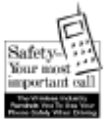
Some menus/features are operator dependent.
2Guidelines for Safe and Efficient Use
•Give full attention to driving - driving safely is your first responsi-
bility.
•Use handsfree operation, if available.
•Pull off the road and park before making or answering a call if
driving conditions so require.
In addition, Ericsson suggests the following safe driving tips if you
are using your phone while driving:
•Get to know your wireless phone and its features such as speed dial
and redial.
•Position your wireless phone within easy reach.
•Suspend conversations during hazardous driv-
ing conditions or situations.
•Do not take notes or look up phone numbers
while driving.
•Dial sensibly and assess the traffic; if possible,
place calls when you are not moving or before
pulling into traffic.
•Do not engage in stressful or emotional conversations that may be
distracting.
•Use your wireless phone to call for help.
•Use your wireless phone to help others in emergencies.
•Call roadside assistance or a special wireless non-emergency assis-
tance number when necessary.
Electronic Devices
Most modern electronic equipment is shielded from RF signals.
However, certain electronic equipment may not be shielded against
RF signals from your wireless phone.
Pacemakers
The Health Industry Manufacturers Association recommends that a
minimum separation of six (6”) inches be maintained between a
handheld wireless phone and a pacemaker to avoid potential inter-
ference with the pacemaker. These recommendations are consistent
with the independent research by and recommendations of Wireless
Technology Research.
Persons with pacemakers:
•Should ALWAYS keep the phone more than six inches from their
pacemaker when the phone is turned ON.
•Should not carry the phone in a breast pocket.
•Should use the ear opposite the pacemaker to minimize the poten-
tial for interference.
•If you have any reason to suspect that interference is taking place,
turn your phone OFF immediately.
Hearing Aids
Some digital wireless phones may interfere with some hearing aids.
In the event of such interference, you may want to consult your ser-
vice provider (or call the customer service line to discuss alterna-
tives).
Other Medical Devices
If you use any other personal medical device, consult the manufac-
turer of your device to determine if it is adequately shielded from
external RF energy. Your physician may be able to assist you in
obtaining this information.
Turn your phone OFF in health care facilities when any regulations
posted in these areas instruct you to do so. Hospitals or health care

Some menus/features are operator dependent.
Guidelines for Safe and Efficient Use 3
facilities may be using equipment that could be sensitive to external
RF energy.
Vehicles
RF signals may affect improperly installed or inadequately shielded
electronic systems in motor vehicles. Check with the manufacturer
or its representative regarding your vehicle. You should also consult
the manufacturer of any equipment that has been added to your
vehicle.
Posted Facilities
Turn your phone OFF in any facility where posted notices so
require.
Aircraft
FCC regulations prohibit using your phone while in the air. Switch
OFF your phone before boarding an aircraft.
Blasting Areas
To avoid interfering with blasting operations, turn your phone OFF
when in a “blasting area” or in areas posted: “Turn off two-way
radio.” Obey all signs and instructions.
Potentially Explosive Atmospheres
Turn your phone OFF when in any area with a potentially explosive
atmosphere and obey all signs and instructions. Sparks in such areas
could cause an explosion or fire resulting in bodily injury or even
death.
Areas with a potentially explosive atmosphere are often but not
always clearly marked. They include fueling areas such as gasoline
stations; below deck on boats; fuel or chemical transfer or storage
facilities; vehicles using liquefied petroleum gas (such as propane or
butane); areas where the air contains chemicals or particles, such as
grain, dust, or metal powders; and any other area where you would
normally be advised to turn off your vehicle engine.
For Vehicles Equipped with an Air Bag
An air bag inflates with great force. DO NOT place objects, includ-
ing both installed or portable wireless equipment, in the area over
the air bag or in the air bag deployment area. If in-vehicle wireless
equipment is improperly installed and the air bag inflates, serious
bodily injury could result.
Product Care and Operation
This device complies with Part 15 of the FCC Rules. Operation is
subject to the following two conditions: 1) This device may not
cause harmful interference, and 2) This device must accept any
interference received, including interference that may cause undes-
ired operation.
Ericsson suggests you read and observe the following for safe care
and operation of your phone:
•Do not allow children to play with your phone. They could hurt
themselves or others, or could accidentally damage the phone.
Your phone may contain small parts that could be detached and
create a choking hazard.
•Do not expose your mobile phone to moisture or extreme temper-
atures.

Some menus/features are operator dependent.
4Guidelines for Safe and Efficient Use
•Only Ericsson original accessories are recommended. Failure to
use them may result in loss of performance or product damage,
and will void the warranty.
•Do not attempt to disassemble the product. Doing so will void
warranty. This product does not contain consumer serviceable
components. Service should only be performed by Authorized Ser-
vice Centers.
•Do not allow objects to fall on, or liquids to spill on products.
•Connect AC (power supply) only to designated power sources as
marked on the product.
•To reduce risk of damage, remove the electrical cord from the out-
let by pulling the AC adapter at the outlet rather than the cord.
•Make sure the electric cord is located so that it will not be stepped
on, tripped over, or otherwise subjected to damage or stress.
•To reduce risk of electric shock, unplug the unit from the power
source before attempting any cleaning. Once unplugged, use a soft
cloth lightly dampened with water for cleaning.
•DANGER - Never alter the AC cord or plug. If the plug will not
fit into the outlet, have a proper outlet installed by a qualified elec-
trician. Improper connection can result in risk of electric shock.
•Don’t twist the antenna. Excess twisting will damage the antenna.
Battery Information
New Batteries
The battery packaged with your phone is not fully charged. For max-
imum battery capacity, use your charger to condition the battery.
Recycling Your Battery
The battery must be disposed of properly. The battery should not be
disposed of in municipal waste. Check local regulations for proper
disposal instructions.
Battery Use and Care
A rechargeable battery has a long service life if treated properly. A
new battery, or one that has not been used for a long period of time,
should be conditioned before using your phone. Avoid recharging a
fully-charged or almost fully-charged battery. If your phone shuts off
due to low battery power, you should charge the battery within 24
hours for the battery to reach full capacity.
This phone is powered by a rechargeable Lithium-Ion (Li-Ion) bat-
tery pack.
WARNING! This battery may explode and cause potential injury if
exposed to or disposed of in a fire.
•Do Not expose the battery to temperatures above 140° F (60°C),
such as in a car parked in the usn or on a hot day.
•Do Not short-circuit the battery’s metal contacts with metallic
objects, such as keys in your pocket, as it may damage the battery.
•Do Not disassemble the battery.
•Use only Ericsson Original accessory chargers (including hands-
free units that act as a charger) and the AC/DC adapter supplied
with your battery charger. Use on a non-Ericsson Original acces-
sory may be hazardous and damage from such use will void your
phone warranty.
•Charging the battery at room temperatures below 41°F (5°C) or
above 113°F (45°C) may degrade battery performance and could
be hazardous.

Some menus/features are operator dependent.
Guidelines for Safe and Efficient Use 5
•Keep away from children and do not allow the battery to be placed
in their mouth. Battery electrolytes may be toxic if swallowed.
Avoid battery electrolyte contact with your skin and eyes.
•Do Not use a damaged battery or charger.
•Turn off your phone before removing the battery.
•Do Not expose the battery to water or other liquids.
•Avoid dropping the battery while removing it from the phone.
•Avoid puncturing or crushing the battery.
•Only use the battery for its intended purpose.
FDA Consumer Update
FDA has been receiving inquiries about the safety of mobile phones,
including cellular phones and PCS phones.
The following summarizes what is known--and what remains
unknown--about whether these products can pose a hazard to health,
and what can be done to minimize any potential risk. This informa-
tion may be used to respond to questions.
Why the concern?
Mobile phones emit low levels of radiofrequency energy (i.e., radiof-
requency radiation) in the microwave range while being used. They
also emit very low levels of radiofrequency energy (RF), considered
non-significant, when in the stand-by mode. It is well known that
high levels of RF can produce biological damage through heating
effects (this is how your microwave oven is able to cook food). How-
ever, it is not known whether, to what extent, or through what mech-
anism, lower levels of RF might cause adverse health effects as well.
Although some research has been done to address these questions, no
clear picture of the biological effects of this type of radiation has
emerged to date. Thus, the available science does not allow us to
conclude that mobile phones are absolutely safe, or that they are
unsafe. However, the available scientific evidence does not demon-
strate any adverse health effects associated with the use of mobile
phones.
What kinds of phones are in question?
Questions have been raised about hand-held mobile phones, the
kind that have a built-in antenna that is positioned close to the user’s
head during normal telephone conversation. These types of mobile
phones are of concern because of the short distance between the
phone’s antenna--the primary source of the RF--and the person’s
head. The exposure to RF from mobile phones in which the antenna
is located at greater distances from the user (on the outside of a car,
for example) is drastically lower than that from hand-held phones,
because a person’s RF exposure decreases rapidly with distance from
the source. The safety of so-called “cordless phones,” which have a
base unit connected to the telephone wiring in a house and which
operate at far lower power levels and frequencies, has not been ques-
tioned.
How much evidence is there that hand-held mobile
phones might be harmful?
Briefly, there is not enough evidence to know for sure, either way;
however, research efforts are on-going. The existing scientific evi-
dence is conflicting and many of the studies that have been done to
date have suffered from flaws in their research methods. Animal
experiments investigating the effects of RF exposures characteristic
of mobile phones have yielded conflicting results. A few animal stud-
Some menus/features are operator dependent.
6Guidelines for Safe and Efficient Use
ies, however, have suggested that low levels of RF could accelerate
the development of cancer in laboratory animals. In one study, mice
genetically altered to be predisposed to developing one type of cancer
developed more than twice as many such cancers when they were
exposed to RF energy compared to controls. There is much uncer-
tainty among scientists about whether results obtained from animal
studies apply to the use of mobile phones. First, it is uncertain how
to apply the results obtained in rats and mice to humans. Second,
many of the studies that showed increased tumor development used
animals that had already been treated with cancer-causing chemicals,
and other studies exposed the animals to the RF virtually continu-
ously--up to 22 hours per day.
For the past five years in the United States, the mobile phone indus-
try has supported research into the safety of mobile phones. This
research has resulted in two findings in particular that merit addi-
tional study:
1 In a hospital-based, case-control study, researchers looked for an
association between mobile phone use and either glioma (a type of
brain cancer) or acoustic neuroma (a benign tumor of the nerve
sheath). No statistically significant association was found between
mobile phone use and acoustic neuroma. There was also no associ-
ation between mobile phone use and gliomas when all types of
types of gliomas were considered together. It should be noted that
the average length of mobile phone exposure in this study was less
than three years.
When 20 types of glioma were considered separately, however, an
association was found between mobile phone use and one rare
type of glioma, neuroepithelliomatous tumors. It is possible with
multiple comparisons of the same sample that this association
occurred by chance. Moreover, the risk did not increase with how
often the mobile phone was used, or the length of the calls. In fact,
the risk actually decreased with cumulative hours of mobile phone
use. Most cancer causing agents increase risk with increased expo-
sure. An ongoing study of brain cancers by the National Cancer
Institute is expected to bear on the accuracy and repeatability of
these results.1
2 Researchers conducted a large battery of laboratory tests to assess
the effects of exposure to mobile phone RF on genetic material.
These included tests for several kinds of abnormalities, including
mutations, chromosomal aberrations, DNA strand breaks, and
structural changes in the genetic material of blood cells called lym-
phocytes. None of the tests showed any effect of the RF except for
the micronucleus assay, which detects structural effects on the
genetic material. The cells in this assay showed changes after expo-
sure to simulated cell phone radiation, but only after 24 hours of
exposure. It is possible that exposing the test cells to radiation for
this long resulted in heating. Since this assay is known to be sensi-
tive to heating, heat alone could have caused the abnormalities to
occur. The data already in the literature on the response of the
micronucleus assay to RF are conflicting. Thus, follow-up research
is necessary.2
FDA is currently working with government, industry, and aca-
demic groups to ensure the proper follow-up to these industry-
funded research findings. Collaboration with the Cellular Tele-
communications Industry Association (CTIA) in particular is
expected to lead to FDA providing research recommendations and
scientific oversight of new CTIA-funded research based on such
recommendations.
Two other studies of interest have been reported recently in the liter-
ature:
Some menus/features are operator dependent.
Guidelines for Safe and Efficient Use 7
1 Two groups of 18 people were exposed to simulated mobile phone
signals under laboratory conditions while they performed cogni-
tive function tests. There were no changes in the subjects’ ability
to recall words, numbers, or pictures, or in their spatial memory,
but they were able to make choices more quickly in one visual test
when they were exposed to simulated mobile phone signals. This
was the only change noted among more than 20 variables com-
pared.3
2 In a study of 209 brain tumor cases and 425 matched controls,
there was no increased risk of brain tumors associated with mobile
phone use. When tumors did exist in certain locations, however,
they were more likely to be on the side of the head where the
mobile phone was used. Because this occurred in only a small
number of cases, the increased likelihood was too small to be sta-
tistically significant.4
In summary, we do not have enough information at this point to
assure the public that there are, or are not, any low incident health
problems associated with use of mobile phones. FDA continues to
work with all parties, including other federal agencies and industry,
to assure that research is undertaken to provide the necessary answers
to the outstanding questions about the safety of mobile phones.
What is known about cases of human cancer that have
been reported in users of hand-held mobile phones?
Some people who have used mobile phones have been diagnosed
with brain cancer. But it is important to understand that this type of
cancer also occurs among people who have not used mobile phones.
In fact, brain cancer occurs in the U.S. population at a rate of about
6 new cases per 100,000 people each year. At that rate, assuming 80
million users of mobile phones (a number increasing at a rate of
about 1 million per month), about 4800 cases of brain cancer would
be expected each year among those 80 million people, whether or
not they used their phones. Thus it is not possible to tell whether
any individual’s cancer arose because of the phone, or whether it
would have happened anyway. A key question is whether the risk of
getting a particular form of cancer is greater among people who use
mobile phones than among the rest of the population. One way to
answer that question is to compare the usage of mobile phones
among people with brain cancer with the use of mobile phones
among appropriately matched people without brain cancer. This is
called a case-control study.
The current case-control study of brain cancers by the National Can-
cer Institute, as well as the follow-up research to be sponsored by
industry, will begin to generate this type of information.
What is FDA’s role concerning the safety of mobile
phones?
Under the law, FDA does not review the safety of radiation-emitting
consumer products such as mobile phones before marketing, as it
does with new drugs or medical devices. However, the agency has
authority to take action if mobile phones are shown to emit radiation
at a level that is hazardous to the user. In such a case, FDA could
require the manufacturers of mobile phones to notify users of the
health hazard and to repair, replace or recall the phones so that the
hazard no longer exists.
Although the existing scientific data do not justify FDA regulatory
actions at this time, FDA has urged the mobile phone industry to
take a number of steps to assure public safety. The agency has recom-
mended that the industry:
•support needed research into possible biological effects of RF of
the type emitted by mobile phones;

Some menus/features are operator dependent.
8Guidelines for Safe and Efficient Use
•design mobile phones in a way that minimizes any RF exposure to
the user that is not necessary for device function; and
•cooperate in providing mobile phone users with the best possible
information on what is known about possible effects of mobile
phone use on human health.
At the same time, FDA belongs to an interagency working group of
the federal agencies that have responsibility for different aspects of
mobile phone safety to ensure a coordinated effort at the federal
level. These agencies are:
•National Institute for Occupational Safety and Health
•Environmental Protection Agency
•Federal Communications Commission
•Occupational Health and Safety Administration
•National Telecommunications and Information Administration
The National Institutes of Health also participates in this group.
In the absence of conclusive information about any pos-
sible risk, what can concerned individuals do?
If there is a risk from these products--and at this point we do not
know that there is--it is probably very small. But if people are con-
cerned about avoiding even potential risks, there are simple steps
they can take to do so. For example, time is a key factor in how
much exposure a person receives. Those persons who spend long
periods of time on their hand-held mobile phones could consider
holding lengthy conversations on conventional phones and reserving
the hand-held models for shorter conversations or for situations
when other types of phones are not available.
People who must conduct extended conversations in their cars every
day could switch to a type of mobile phone that places more distance
between their bodies and the source of the RF, since the exposure
level drops off dramatically with distance. For example, they could
switch to:
•a mobile phone in which the antenna is located outside the vehi-
cle,
•a hand-held phone with a built-in antenna connected to a differ-
ent antenna mounted on the outside of the car or built into a sep-
arate package, or
•a headset with a remote antenna to a mobile phone carried at the
waist.
Again, the scientific data do not demonstrate that mobile phones are
harmful. But if people are concerned about the radiofrequency
energy from these products, taking the simple precautions outlined
above can reduce any possible risk.

Some menus/features are operator dependent.
Guidelines for Safe and Efficient Use 9
Where can I find additional information?
For additional information, see the following websites:
•Federal Communications Commission (FCC) RF Safety Program
(select “Information on Human Exposure to RF Fields from Cel-
lular and PCS Radio Transmitters”)
http://www.fcc.gov/oet/rfsafety
•World Health Organization (WHO) International Commission
on Non-Ionizing Radiation Protection (select Qs & As)
http://www.who.int/emf
•United Kingdom, National Radiological Protection Board
http://www.nrpb.org.uk
•Cellular Telecommunications Industry Association (CTIA)
http://www.wow-com.com
•U.S. Food and Drug Administration (FDA) Center for Devices
and Radiological Health
http://www.fda.gov/cdrh/consumer/
Footnotes
1 Muscat et al. Epidemiological Study of Cellular Telephone Use
and Malignant Brain Tumors. In: State of the Science Sympo-
sium;1999 June 20; Long Beach, California.
2 Tice et al. Tests of mobile phone signals for activity in genotoxicity
and other laboratory assays. In: Annual Meeting of the Environ-
mental Mutagen Society; March 29, 1999, Washington, D.C.;
and personal communication, unpublished results.
3 Preece, AW, Iwi, G, Davies-Smith, A, Wesnes, K, Butler, S, Lim,
E, and Varey, A. Effect of a 915-MHz simulated mobile phone sig-
nal on cognitive function in man. Int. J. Radiat. Biol., April 8,
1999.
4 Hardell, L, Nasman, A, Pahlson, A, Hallquist, A and Mild, KH.
Use of cellular telephones and the risk for brain tumors: a case-
control study. Int. J. Oncol., 15: 113-116, 1999.

Some menus/features are operator dependent.
10 A2218z Features
Advice of Charge
Enables you to monitor the cost of calls made from your mobile
phone. Details of the last call and total calls made are shown in the
phone’s display. See “Call Information” on page 47.
Alternate Line Service
Enables you to have two lines with two different phone numbers on
a single mobile phone subscription. This makes it possible to have
separate numbers for business and personal calls. See “Using Two
Voice Line s” on page 55.
Area Information
Area Information is another type of text message which is sent to all
subscribers in a certain network area. The information may be a local
road report or a phone number to a local taxi. See “Area Informa-
tion” on page 45.
Ask to Save
Prompts you to save names and numbers in your Phone Book when
the phone does not recognize the number of the most recent call. See
“Display Language” on page 17.
Calendar
Calendar is an appointment manager that can hold up to 100
appointments. Allows viewing by day, week, or month. See “Calen-
dar” on page 59.
Caller identification Services
Identifies, by name or number, who is calling you. See “Using the
Call List” on page 35.
Closed User Group
Limits outgoing calls to specified numbers. This can be very useful
when operators give lower rates for specific groups. See “Closed User
Groups” on page 51.
Demonstration
A hands-off demonstration of the phone’s menus. See “Demonstra-
tion” on page 13.
Fixed Dialing
Allows calls to be made only to certain numbers saved on the SIM
card. If an attempt is made to call other numbers, the message
Number not permitted
appears in the display. See “Fixed Dialing” on
page 50.
Forward Calls
Lets you forward your voice, fax, and data calls, provided your sub-
scription supports fax and data calls. These options are available:
•All Voice Calls - forward all voice calls
•When Busy - forward calls if you are already on the phone
A2218z Features
Some menus/features are operator dependent.
A2218z Features 11
•No Reply - forward calls that you do not answer within a specified
time limit (operator dependent)
•Not Reachable - forward calls if your phone is turned off or if you
are unreachable
See “Call Forwarding” on page 49.
Games
Tetr is®, Erix, Maze, and Solitaire. See “Games” on page 66.
Lithium Ion Battery
This high capacity Lithium Ion (LiIon) battery has no memory
effect and is lightweight with highest energy density.
Keypad Lock
Helps you to avoid accidental dialing, which can happen if you keep
your phone in your pocket. You can choose between manual and
automatic keylock. See “Keypad Lock” on page 65.
Menu Help
Appears if you pause briefly while browsing your menu system. The
help texts will self-scroll through the descriptions of some features.
See “Display Language” on page 17.
Mobile Wiz™
Steps you through the initial setup of the phone and manages the
top 10 settings: language, date, date format, time, ring signal, ring
volume, auto keylock, menu help, message alert, and T9® predictive
text input. See “Mobile Wiz™” on page 16.
Network Initiated Time Zone (NITZ)
Updates your phone’s internal clock as you enter new time zones. See
“More Personalization Options” on page 26.
Online Services
Your network operators’ way of offering customized services, inde-
pendently of mobile phones and mobile phone manufacturers. See
“Online Services” on page 70.
Phone Book
Allows 200 entries in the phone in addition to the number of entries
offered on your SIM. See “Your Phone Book” on page 30.
Predictive Text Input (Tegic® T9®)
Makes entering SMS messages and phone book entries much easier.
Although you will still use the keypad to enter letters/characters, the
software will recognize what you are trying to enter. This feature is
especially helpful when entering SMS messages and the Phone Book
names. You can use the # key to toggle between input methods. To
change input methods, see “More Personalization Options” on
page 26.
Profiles
Settings which are set to suit a certain environment. For example,
when you go to a meeting, you can choose the
Meeting
profile and a
number of settings that suit a meeting are set. See “Profiles” on
page 28.
Some menus/features are operator dependent.
12 A2218z Features
Security
Protects your phone and subscription from unauthorized use with
security features such as Phone Lock, SIM Lock, and Keypad Lock.
See “Security” on page 64.
Short Message Service (SMS)
SMS allows you to send and receive text messages. With the new
SMS Concatenation feature, longer messages are accepted. If the
recipient of your message does not have this service, your message
will be sent as several short messages. SMS is also used by many net-
work operators to notify you of a new voicemail message. See “Te xt
Messaging (SMS)” on page 41.
SMS Templates
Saves up to five standard message templates that can be reused when-
ever you want. Each template can consist of 30 characters each. Your
templates are saved in the phone memory. See “Temp la tes f or Te xt
Messages” on page 42.
Stopwatch
Times certain activities with your phone’s built-in stopwatch. See
“Stopwatch” on page 68.
Voice Recognition
Making and receiving calls is even easier when your phone recognizes
your voice commands. See “Voice Activation” on page 57.
Voicemail
Allows callers to leave a voice message when you cannot answer your
calls. See “Voicemail Service” on page 39.
Wireless Application Protocol (WAP)
An open, global specification that makes it possible for mobile users
with wireless devices to connect to the Internet and access specially
designed interactive services and view WAP pages. See See “Using
the WAP Browser” on page 73.
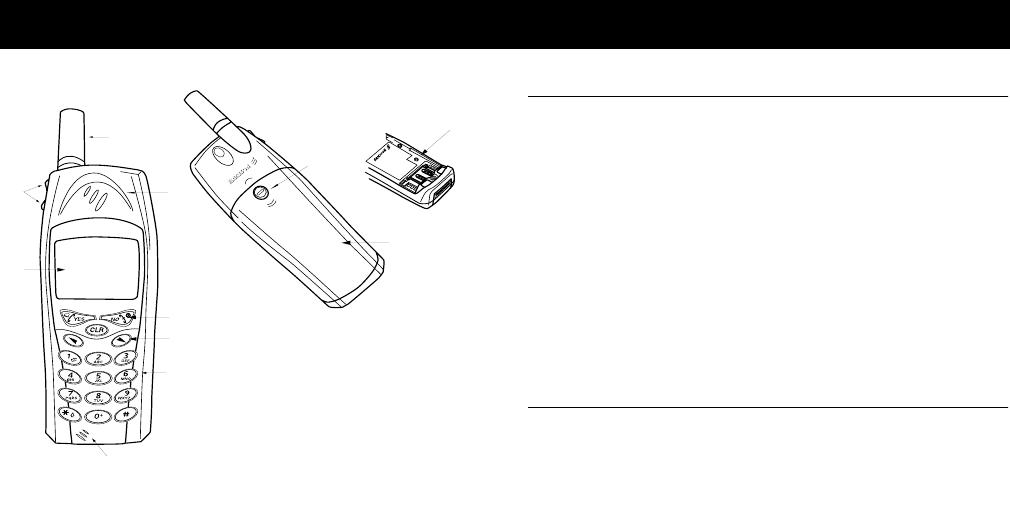
Some menus/features are operator dependent.
Getting Started 13
Demonstration
Before using your phone, you may wish to view the hands-off dem-
onstration. The demonstration will preview the start-up show, menu
system, help texts, language settings, Wireless Application Protocol
(WAP®), and Standby mode.
Note! The demonstration runs without a SIM card inserted. The demon-
stration will not prevent you from making emergency calls to 911 (or
112, the international emergency number).
Insert Card or Press Yes for demo
will appear. Press YES to run the
demonstration. You can end the demonstration at any time by press-
ing any key.
Assembling Your Phone
Assembling your phone in five easy steps:
1 Remove the Battery Cover
2 Insert SIM Card
3 Attach the Battery
4 Replace the Battery Cover
5 Charge the Battery
Getting Started
1 Antenna
2 Earpiece
3 NO (ON/OFF) Key
4 Navigation Keys
5 Keypad
6 Microphone
7 Display
8 Side Volume Keys
9 Battery Release Latch
10 Battery Cover
11 Hardware Reset Button
1
2
3
4
5
6
7
8
9
10
11
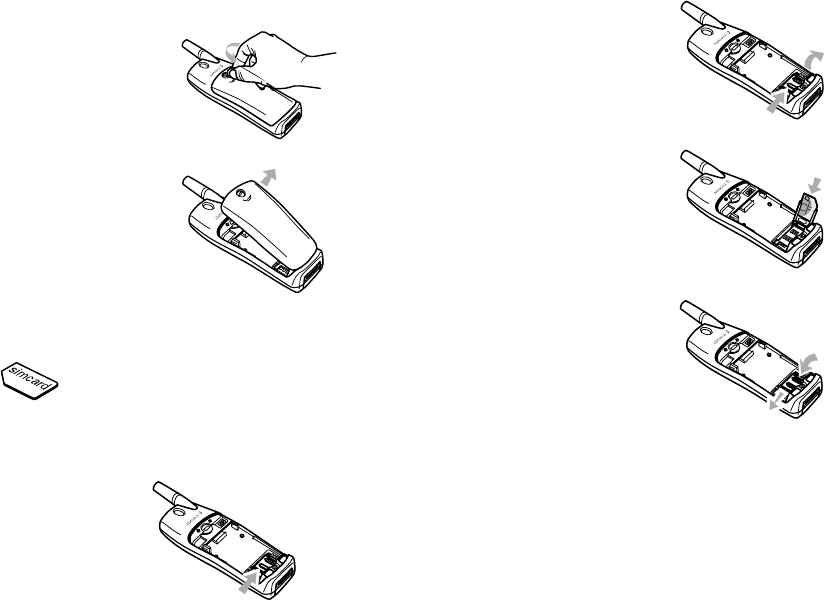
Some menus/features are operator dependent.
14 Getting Started
Step 1: Remove the Battery Cover
Step 2: Insert the SIM Card
When you register as a subscriber with a network opera-
tor, you get a SIM (Subscriber Identity Module) card.
The SIM card contains a computer chip that keeps track
of your phone number, the services included in your subscription,
your Phone Book information, and other information. Note! Remove the SIM by unlatching the holder, raising the edge of the
SIM card, and sliding it out.
1 Use a coin or your fingernail
to turn the latch counterclock-
wise.
2 Once the screw has been loos-
ened sufficiently, remove the
battery cover.
1 Locate the SIM card
holder on the back of the
phone and slide the
holder to the right until it
unlatches.
2 Lift the holder up.
3 Insert the SIM card with
the cut corner to the top
right (a diagram of proper
card insertion appears on
the front side of the SIM
card holder).
4 Lower the SIM card latch
and slide back to the left
to lock the holder in
place.
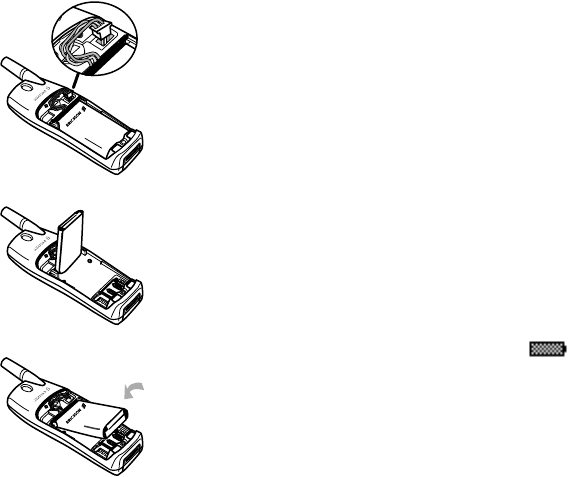
Some menus/features are operator dependent.
Getting Started 15
Step 3: Attach the Battery
Note! Remove the battery by removing the back panel as described above.
Raise the battery and slide it out of the hinges - one side at a time.
Step 4: Replace Battery Cover
1 Insert the cover, bottom first, on the back of the phone.
2 Turn the screw clockwise to tighten.
Step 5: Charge the Battery
When to Charge
Note! For detailed information on safely handling your LiIon battery, see
“Battery Information” on page 4.
Your phone comes with a LiIon battery. The battery is not charged
when you buy your phone, but there may be enough power to switch
the phone on. You should fully charge the battery before use. It is
safe to make and receive calls while your phone is charging. You
should not need to remove your battery after it is installed. Your bat-
tery can be charged whenever you wish without affecting its perfor-
mance. You can also charge the battery when the phone is off.
The battery meter icon on your standby screen indicates how much
remaining strength your battery has.
Tip! If you have an Ericsson-approved battery, you can check the remain-
ing talk and standby times in the STATUS menu using the side vol-
ume keys when in standby mode. The total remaining standby and
talk time depends on the type of battery you use and your position
in the network. Please note that these times are approximate and you
may have 20% less time than is shown in the display.
Note! The phone turns itself off when the battery can no longer power it
satisfactorily.
1 Locate the connector at the end of the
blue, red, and black wires. Insert the
plug as shown in the diagram.
Note! The cable will only properly
fit one way - do not force it.
2 Holding the battery at a perpendicu-
lar angle, slip the left side of the bat-
tery into the hinge. Snap the right side
in.
3 Lower the battery until it lays flat.

Some menus/features are operator dependent.
16 Getting Started
Charging Indicators
•Needs Charging
Attention! Battery low
appears in the display. Alarm signal sounds
(short beep)
•Currently Charging
Optimized Charging
briefly appears in display (only with Ericsson-
approved batteries). The meter in display pulses continuously.
•Non Ericsson-Approved Battery
Charging Battery
appears in display and battery charges very slowly.
Charging
1 Make sure that the battery is attached to the phone.
2 Connect the charger to the electrical outlet.
3 Connect the charger to the phone as shown in the picture. The
flash symbol on the plug must face upwards.
Note! The main electrical plug may look different depending on the elec-
trical socket in your country. The plug may not be used for other
products than Ericsson chargers.
Disconnecting the Charger
Move the plug connected to the phone
upwards to remove it, as shown in the picture.
Powering On Your Phone
Press and hold the NO key to turn the phone
On
and
Off
.
If “PIN:” Appears in the Display
Most SIM cards are supplied with a security code, also known as
PIN (Personal Identity Number), which you need to access the net-
work. When you turn on your phone, you may be asked to enter
your PIN. You will find your PIN in the information provided by
your operator. Some operators may have services that require a sec-
ond PIN, your PIN2.
If
PIN:
appears in the display after you have turned on the phone:
1 Enter your PIN. If you make a mistake while entering your PIN,
erase the wrong number by pressing the CLR key.
2 Press
YES.
If your PIN is entered incorrectly three times in a row, the SIM card
is blocked. You can unblock it by using your PUK. See “SIM Card
Lock” on page 64. If
Phone locked
appears in the display, enter your
phone lock code. The default phone lock code is 0000. See “Phone
Lock” on page 64.
Network Search
After you have turned on the phone (and entered your PIN), the
phone searches for a network. When a network is found, the phone
beeps three times. Your network operator’s name (abbreviated in
most cases) appears in the display.
This is called
Standby Mode
. You can now make and receive calls.
Mobile Wiz™
Mobile Wiz™ setup wizard will guide you through the initial setup
of your phone. This feature manages 10 major settings: language,
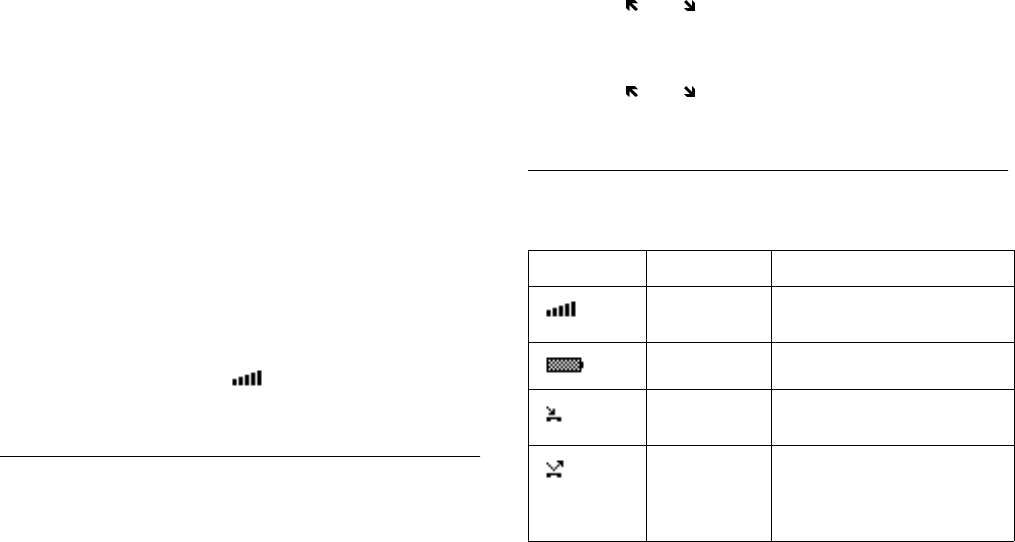
Some menus/features are operator dependent.
Getting Started 17
date, date format, time, ring signal, ring volume, auto keylock, menu
help, message alert, and T9® predictive text input.
The wizard will start with brief animation when you power on your
phone. A help screen will appear before each setting. Press YES to
enter the setting. A message will indicate where you are in the wiz-
ard’s settings (for instance, 2 of 10 will indicate that you are in the
second setting - date).You can also use the numeric keys to enter a
specific help screen (for instance, press 2 to enter the help screen for
setting the date). Press NO to exit the menu and return to the wizard.
Aborting the Wizard
1 Press NO while
Mobile Wiz
is running.
Postpone Mobile Wiz?
appears
2 Press
YES to temporarily postpone (the Wizard will appear the
next time you power On) or NO to permanently abort.
Note! Mobile Wiz is always available under EXTRAS.
1 Select EXTRAS .
2 Select
Mobile Wiz
and follow the prompts.
Signal Strength
The signal strength icon indicates how strong your signal is. More
bars indicate more strength.
Display Language
Most SIM cards automatically set the display language to the lan-
guage of the country where you bought your SIM card (
Automatic
).
If this is not the case, the preset language is
English
. You can easily
reset your phone to English or the automatic language if you do not
understand the language that appears.
Reset to English
If not in standby mode, press and hold the NO key to go to standby >
enter 0000 .
Reset to Automatic
If not in standby mode, press and hold the NO key to go to standby >
enter 8888 .
Display Icons
This table shows all possible display icons. Some of the features rep-
resented in this table are network dependent.
Icon Name Explanation
Signal strength Tells you the strength of the
network signal.
Battery meter Tells you the status of the battery.
Missed call
indicator
You have missed an incoming call.
Forward
indicator
Accept Some/
None indicator
All incoming calls will be
forwarded to a defined number.
No calls or only certain calls from
numbers in a list are received.
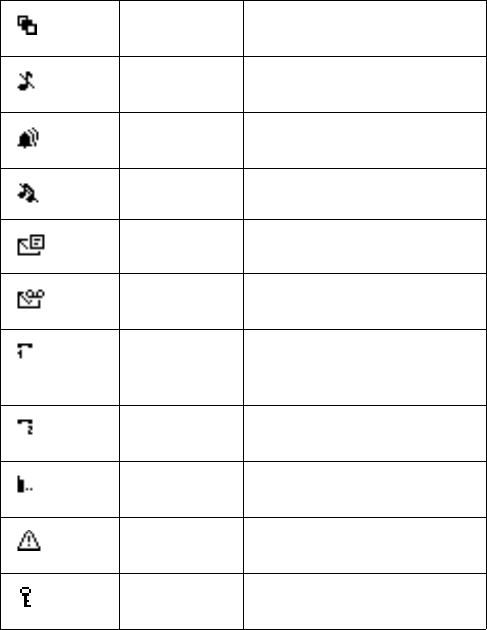
Some menus/features are operator dependent.
18 Getting Started
Profile
indicator
A profile, other than Normal, has
been chosen.
Ring signal off
indicator
No sound can be heard when you
receive a call.
Alarm indicator The alarm clock has been set and is
on.
Silent indicator All audible signals are turned off.
SMS indicator You have received a text message.
Voice mail
indicator
You have received a voice message.
Line 1
indicator
Line 1 is in use for outgoing calls -
if you subscribe to the Two Line
Service
Line 2
indicator
Line 2 is in use - if you subscribe to
the Two Line Service.
Infrared
modem
The infrared modem appears if a
modem is attached.
Ciphering
indicator
Ciphering is currently not being
provided by the network.
Keylock
indicator
Indicates that the keypad is locked.

Some menus/features are operator dependent.
Using Menus 19
The menus are arranged in a loop, which you enter and move (scroll)
through with the or keys or by using shortcuts. Each menu
contains a list of options. Some menus have submenus with addi-
tional options. The complete menu system is diagramed on the
inside front cover of this user’s guide.
Moving Through the Menus
Menu System
Your phone has seven main menus. You enter the menus by pressing
or . At the top of the display there are icons symbolizing each
menu. The icon is enlarged when the menu is selected. In the dia-
gram below, the Phone Book menu is selected. Refer to the front of
this User’s Guide for a diagram of the complete menu structure.
You phone contains seven menus:
•Menu 1 - Phone Book
•Menu 2 - Messages
•Menu 3 - Call Info/Ongoing Call
•Menu 4 - Settings
•Menu 5 - Extras
•Menu 6 - WAP Services
•Menu 7 - My Shortcuts
Display Text
When you move through the menu sys-
tem, the display changes. The following
hints can help you:
•Black text within a frame at the top
indicates the menu you have chosen
(for example, CALL INFO). Press YES to enter the menu.
•White text on a black layer indicates your position in the submenu
system. Press YES to enter this submenu or select this setting.
Using Menus
Press... to...
or switch between menus or functions
YES select a menu, submenu or setting
NO go back one level in the menu system,
exit a setting or leave a setting unchanged,
press and hold to return to standby mode
CLR delete an item from a list

Some menus/features are operator dependent.
20 Using Menus
•Grey text indicates a function that is temporarily unavailable, not
included in your subscription, or is not activated.
•Text marked with a tick or filled
radio button indicates the current
setting or settings selected.
Menu Help
Menu Help
appears if you pause briefly while browsing your menu
system. The help texts will self-scroll through the descriptions of
some features. Menu Help will be activated when you purchase your
phone. You can turn off
Menu Help
through the
Mobile Wiz
or
through the SETTINGS menu.
SETTINGS > YES >
Display
> YES >
Menu Help
>
Off
> YES (The
menu help icon identifies help text.)
Paths in This User’s Guide
Throughout this user’s guide, you will find “paths” that will lead you
through a series of steps. Also, in this user’s guide, menu names
appear in bold all capital letters (SETTINGS) and submenus appear in
bold and mixed case alphabet (
Sounds & Alerts
).
The following example shows the path you would follow to change
your alarm clock signal. You will also see the step-by-step explana-
tion for changing the alarm clock signal. You can always return to
standby by pressing NO.
SETTINGS > YES >
Sounds & Alerts
> YES >
Alarm Signal
> YES >
select a setting > YES.
1 Scroll to SETTINGS menu.
2 Press
YES.
3 Scroll to
Sounds & Alerts
submenu.
4 Press
YES.
5 Select
Alarm Signal.
6 Press YES.
7 Scroll to the setting that you want.
8 Press YES.
Note! Phone numbers used in this User’s Guide are for example only. We
do not recommend dialing these numbers.
My Shortcuts
A quicker way to move through the menus is to use the shortcuts.
When you buy your phone, the MY SHORTCUTS menu contains a
few settings which you can remove if you wish. You can also add a
setting from another menu to MYSHORTCUTS. In this way, you can
reach the settings you use most, quickly and easily.
Tip! You can quickly access the first submenu in MY SHORTCUTS by
pressing and holding .
Note! Your phone may not have all the menu alternatives described in this
manual since many of them are network and subscription depen-
dent. Because of this, the shortcut numbers may vary between
phones.
Adding a Setting to My Shortcuts
1 Scroll to MY SHORTCUTS > YES >
Edit Shortcuts
> YES.
2 Select a setting from the list by pressing *or #. A check will appear
in the box next to the menu.
Some menus/features are operator dependent.
Using Menus 21
3 The first available position will appear or you can enter the posi-
tion number you want for your setting in this menu.
4 Press
YES.If you want to add another setting, repeat steps 2 and 3.
To remov e a set tin g from MY SHORTCUTS, repeat steps 1 and 2.
5 Press
YES to exit the list.

Some menus/features are operator dependent.
22 Making and Receiving Calls
Making and Receiving Calls
In this chapter, we assume that you have turned on your phone and
that you are within range of a network.
1 Enter the phone number (you must also add the area code, city
code, or country code if you are calling outside your local area).
2 Press YES.
Note! When you are engaged in a call, the ongoing call icon appears and
the CALL INFO menu is replaced with ONGOING CALL.
Ending a Call
Press NO to end the call.
Ask to Save
Ask to Save
prompts you to save names and numbers in your Phone
Book when the phone does not recognize the number of the most
recent call.
Ask to Save
will be turned On when you purchase your
phone. To turn Ask to Save off:
PHONE BOOK > YES >
Options
> YES >
Ask to Save
> Off > YES
Redialing a Previously Called Number
In the
Call List
you find numbers that you have dialed, answered or
missed.
YES >
Call List
> scroll to the number you want to call > YES
For more information, see “Using the Call List” on page 35.
Automatic Redialing
If the network is busy when you first called, the display shows
Retry?
.
You can now redial the number by pressing YES. Your phone auto-
matically redials (up to 10 times):
•until the call is answered. When the call is successfully connected,
you hear a ring signal
•until you press a key or receive a call
Note! Automatic redialing is not available for fax and data calls.
Making International Calls
1 Press and hold the 0 key until a + sign appears.
2 The
+ replaces the international prefix number of the country
from which you are calling.
3 Enter the phone number.
4 Press
YES.
Note! Entering the + symbol is not necessary if you have entered the inter-
national prefix.
Making Emergency Calls
1 Enter 911 (or 112, the international emergency number).
Making and Receiving Calls

Some menus/features are operator dependent.
Making and Receiving Calls 23
2 Press
YES.
Note! The emergency numbers 911 and 112 can normally be used in any
country, with or without a SIM card inserted, if a GSM network is
within range. Some network operators may require that a SIM card
is inserted, and in some cases that the PIN code has been entered as
well. Some networks may not use the international emergency num-
ber 112 (or 911). Operators may designate additional emergency
numbers. Refer to your operator for more information.
Receiving a Call
When you receive a call, the phone rings and the display shows
Answer?
Press YES to answer the call.
Note! If your subscription includes the Calling Line Identification (CLI)
service and the caller’s network sends the number, you see the caller’s
number in the display. If your subscription supports Calling Party
Name (CNAP), the caller’s name will also appear. If the incoming
call is a restricted number, the display shows
Withheld.
Muting the Ringer
Temporarily silence the ringer by pressing CLR when a call is incom-
ing.
Rejecting a Call
•Press either side volume key twice.
or
•Press NO.
The display shows
Busy signal
and the phone number of the caller
will appear (if available). The caller hears a busy tone if this is sup-
ported by the caller’s subscription. If
Forward Calls When Busy
is on,
the call is forwarded to the number you have specified. See “For-
warding Incoming Calls” on page 53.
Ciphering
Ciphering is a built-in feature that scrambles your calls and
messages to provide additional privacy. An exclamation mark
is shown in the display during a call to indicate that ciphering is cur-
rently not being provided by the network.
During a Call
Your phone has several functions, which you might find helpful
while a call is in progress.
Changing the Listening Volume
You can easily change the listening volume during a call by pressing
the side volume keys.
•Upper key will increase the volume.
•Lower key will decrease the volume.
Muting the Microphone
1 Press and hold down the CLR key.
Muted
appears in the display.
2 To continue your conversation, release the CLR key.
Note! Instead of pressing and holding the CLR key, you can put the call on
hold.
Putting a Call on Hold
1 Press YES.
Call held
appears in the display.
Some menus/features are operator dependent.
24 Making and Receiving Calls
2 To continue your conversation, press YES again.
Sending Tone Signals
To use telephone banking services or to control an answering
machine, you need to use codes. These codes are sent as tone signals
(also known as DTMF tones or touch tones). With your mobile
phone, you may use these codes during a call. If you press 0-9, * and
# during a call, these numbers and characters are sent as tone signals.
Note! You can also save codes only or codes together with a phone number
in your Phone Book. See “Telephone Banking Services” on page 33.
However, it may be a risk to save your codes in the phone in case it is
stolen.
The Notepad
If you want to make a note of a phone number during a call, you can
use your phone display as a notepad. When you end the call, the
number remains in the display or, if
Ask to Save
is
On
, you will be
asked to save the number in your phone book. You can also find the
number in
Add Number
in the
P
HONE
B
OOK
menu. See “Creating a
Phone Book Entry” on page 30.
Checking the Duration or Cost of the Call
During a call, the display normally shows the duration in minutes
and seconds. Depending on your subscription, you may see the call
cost displayed instead.
Minute Minder
If you turn on the minute minder, you hear a beep once every
minute during a call as a reminder of the duration of the ongoing
call. See “More Personalization Options” on page 26.
More than One Call Simultaneously
Your phone is capable of handling more than one call simulta-
neously. When you press YES to answer the second call, the first call
will automatically be put on hold. You can also set up a conference
call with up to five people. See “Handling Multiple Calls” on
page 53.

Some menus/features are operator dependent.
Personalizing Your Phone 25
Ring Signals
Silent Ring Signal
Press and hold CLR >
Tur n o n S il e n t
/Turn off Silent > YES. An icon
appears in standby.
Note! All audible signals are turned off.
Ring Signal Volume
You can set the volume in six steps. The first step means that two
clicks are heard when you receive a call. You can also turn the ring
signal off (0). An icon then appears in standby.
SETTINGS > YES >
Sounds & Alerts
> YES >
Ring Volume
> YES (The
level of the ring volume appears in the display. Use or to
increase or decrease the volume. The phone rings once with the
actual setting as you increase the volume.) > YES.
Note! Use the side volume keys to change the volume silently.
Increasing Ring
SETTINGS > YES >
Sounds & Alerts
> YES >
Increasing Ring
> YES >
On
.
The Increasing Ring must be Off for the ring signal volume to
apply.
Note! When increasing ring is activated, you will receive a warning if you
attempt to change the ring volume or set silent mode.
Ring Signal Type
Choosing an existing ring signal
SETTINGS > YES >
Sounds & Alerts
> YES >
Ring Signals
> YES >
Voice Calls
> YES > select the ring signal type that you want > YES.
Note! When scrolling through the list, the melody currently stored in the
highlighted position is played. If you do not wish to disturb other
people, use the volume keys on the side of the phone to scroll
silently.
Different Ring Signals
If you subscribe to the Two Line Service, you can set different ring
signals for the two lines. Line 1 and Line 2 are displayed instead of
Voice. Provided your SIM subscription supports Fax and Data calls,
you can set different ring signals for voice, fax and data calls respec-
tively.
Specific Ring Signals for Personal Calls
If your subscription includes the Calling Line Identification (CLI)
service, you can assign a personal ring signal to up to 10 callers.
Tip! You can have one ring signal for a friend and another one for a col-
league. If the last seven digits of a caller’s number correspond to a
number you have specified, then that caller’s ring signal is used.
Personalizing Your Phone

Some menus/features are operator dependent.
26 Personalizing Your Phone
Tip! You can include question marks (?) in a phone number. If you enter
919555???, calls from phone numbers between 919555000 and
919555999 will have the same personal ring signal. You get a ques-
tion mark by pressing and holding #. For more information on
entering phone book entries, see “Creating a Phone Book Entry” on
page 30.
Specifying a Caller’s Number and Ring Signal
SETTINGS > YES >
Sounds & Alerts
> YES >
Ring Signals
> YES >
Per-
sonal Rings
> YES >
Add new?
> YES
>
Enter the caller’s number >
YES > Select the ring signal type you want > YES
Deleting a Caller’s Number
SETTINGS > YES >
Sounds & Alerts
> YES >
Ring Signals
> YES >
Per-
sonal Rings
> YES > scroll to the number you wish to delete > YES >
Delete
> YES
Composing and Editing Your Own Ring Signals
You can compose four different ring signals.
1 SETTINGS > YES >
Sounds & Alerts >
YES >
My Mel-
odies
> YES > Select
My Melody 1, My Melody 2, My
Melody 3
or
My Melody 4
>
Press CLR to clear the
display.
2 The keypad now works as a keyboard (see figure in
margin above).
Use the keypad to enter notes:
•Press and hold a key to enter a long note.
•Press 0 to raise the note one octave.
•Press # once to raise the note one halftone.
•Press # twice to lower the note one halftone.
3 To listen to your melody, press YES.
4 Press
YES again to save it or press NO to continue editing.
Editing a ring signal
SETTINGS > YES >
Sounds & Alerts
> YES >
My Melodies
> YES >
scroll to either
My Melody 1, My Melody 2, My Melody 3
or
My
Melody4
> YES >
Edit
.
The notes are displayed and you can edit the melody notes with the
keys. Press YES to play it.
Note! You can also compose your own and download existing ring melo-
dies from the Ericsson Mobile Internet:
http://mobileinternet.ericsson.com
More Personalization Options
B
Alarm Signal SETTINGS > YES >
Sounds & Alerts
> YES
>
Alarm Signal
> YES > select a setting > YES
Ask to Save PHONE BOOK > YES >
Options
> YES >
Ask to Save
>
On
/Off > YES
Network Initiated
Time Zone (NITZ)
SETTINGS > YES >
Time and Date
> YES >
Auto Time
Zone
> YES >
On
/Off
>
YES

Some menus/features are operator dependent.
Personalizing Your Phone 27
Date SETTINGS > YES >
Time and Date
> YES >
Set
Date
>
YES > enter the year (two digits), month, and day
>
YES
Note! If you have chosen another date format you
must enter the date differently.
Date Format SETTINGS > YES >
Time and Date
> YES >
Date Format
> YES >
s
elect date format
> YES
Display Language SETTINGS > YES >
Language
> YES >
Set Menus
> YES
> select language > YES
Note! From standby, enter 0000 to choose
English
. Enter 8888 to chose
Automatic
.
Display Light SETTINGS > YES >
Display
> YES >
Light
> YES >
select setting > YES
Input Method SETTINGS > YES >
Language
> YES >
Input
> YES > *
to select or deselect an input method > YES
Note! Press and hold # to toggle between input
methods when you are entering or editing a
phone book entry or a message.
Key Sound SETTINGS > YES >
Sounds & Alerts
> YES >
Key Sound
> YES > select a setting > YES
Master Reset SETTINGS > YES >
Master Reset
> YES >
e
nter the
phone lock code
> YES >
Menu Help SETTINGS > YES >
Display
> YES >
Menu Help
>
On
/
Off
> YES
Message Signal SETTINGS > YES >
Sounds & Alerts
>YES
>
Message Alert
> YES > select a setting > YES
Minute Minder CALL INFO > YES >
Call Timers
> YES >
Minute Minder
> YES >
On
/Off > YES
New Greeting SETTINGS > YES >
Display
> YES >
User Greeting
>
YES >
Custom
> YES > compose greeting > YES
Phone Number
Display
SETTINGS > YES >
Display
> YES >
My Numbers >
YES
> Voic
e
>
YES
>
enter the number
>
YES
(This path may vary depending on other activated
features.)
Standard Greeting SETTINGS > YES >
Display
> YES >
User Greeting
>
YES >
Standard
> YES
Time Format SETTINGS > YES >
Time and Date
> YES >
Time Format
> YES >
s
elect 24-hour or 12-hour format (am/pm)
>
YES
Time/Clock SETTINGS > YES >
Time and Date
> YES >
Set Time
>
YES > enter the time in hours and minutes
>
YES
Note! Use # to toggle between am/pm.
Tur n Of f Gre e t in g SETTINGS > YES >
Display
> YES >
User Greeting
>
YES >
Off
> YES
Tur n To n e s O n/ O f f ONGOING CALL > YES >
Tur n O ff
/On
Tone s
> YES
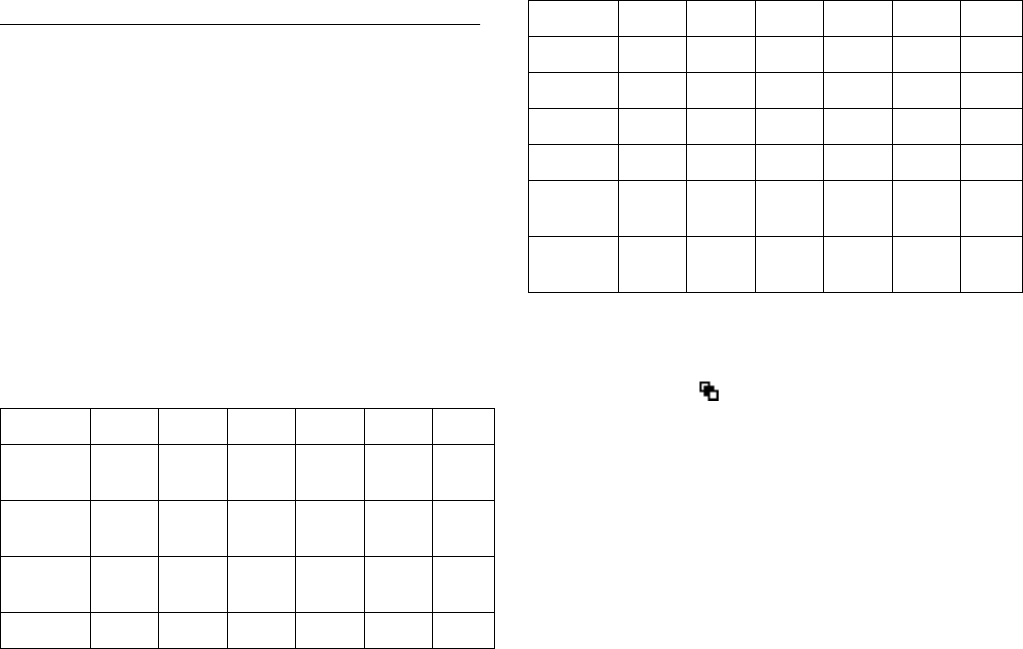
Some menus/features are operator dependent.
28 Personalizing Your Phone
Profiles
Your phone is always set to one of the six profiles. When you buy
your phone, it is set to the Normal profile. You cannot create more
profiles, but you can change the name of a profile, change the set-
tings included in a profile, or add an accessory to a certain profile.
Press the side volume key (in standby mode) to find out which pro-
file you are currently in.
There are six programmed profiles:
•Normal
•Meeting
•In Car
•Outdoors
•Port H-free (portable handsfree)
•Home
The table below shows the settings of each profile.
Choosing a Profile Manually
You can always choose to use another profile than the one you cur-
rently use. If you choose another profile besides Normal, an icon is
shown in standby.
SETTINGS > YES > Profiles > YES > Select Profile > YES > select the
profile you want > YES.
Note! You can also find Select Profile in the My Shortcuts menu.
Note! A profile with no accessories associated, such as
Meeting
or
Normal
,
must be chosen manually, even if automatic activation is on. The
profiles associated with accessories can be chosen automatically.
Changing the Profile Settings
You can rename the pre-programmed profiles and change the set-
tings according to your wishes.
Profile Name Norm Meet Car Out H-free Home
Ring
Vol ume
5(6) 0(6) 6(6) 6(6) 6(6) 5(6)
Increasing
Ring
Off Off Off Off Off Off
Accept Calls From All From All From All From All From All From All
Forward Calls Off Off Off Off Off Off
Calling Cards None None None None None None
Light Auto Auto On Auto Auto Auto
Line 1/2 L1L1L1L1L1L1
Silent OffOnOffOffOffOff
Auto
Activation
Off Off On Off On Off
Accessories --
Car
Handsfree
-Handsfree
-
Profile Name Norm Meet Car Out H-free Home

Some menus/features are operator dependent.
Personalizing Your Phone 29
Changing a Profile Setting
SETTINGS > YES > Profiles > YES > Edit Profile >YES (a list of the
profile settings appears) > YES to select > change the profile setting
according to your wishes.
Note! You cannot change the name of the Normal profile.
If you change a setting which is included in a certain profile, the pro-
file is updated. With the Reset Profiles function, you can change all
profile settings back to the way they were set when you bought your
phone.
Resetting the Profile Settings
SETTINGS > YES > Profiles > YES > Reset Profiles >YES > answer
YES if you are sure you want to reset all profiles.
Turning Automatic Activation On/Off
SETTINGS > YES > Profiles > YES >
Edit Profiles
> YES > Auto Acti-
vation > YES > Select On or Off.
Adding Accessories to a Profile
You can add one or many accessories to a profile.
Tip! If you usually use a portable handsfree together with a specific
charger, you may add the charger to the Port H-free profile. The
phone recognizes the accessory as it is connected and switches profile
automatically.
Note! The first accessory that is connected to the phone which switches the
profile. Only profiles associated with accessories can be activated
automatically. You must first choose the profile manually to which
you want to add an accessory, see “Choosing a Profile Manually” on
page 28.
Adding an Accessory to a Profile
Note! You cannot add an accessory to the Normal profile.
1 SETTINGS > YES > Profiles > YES >
Edit Profiles
> YES > Accesso-
ries >YES. Now you are in the list of the accessories which are
already associated with the profile.
2 Select Add accessory?.
3 Select an accessory. The question Automatic activation on?
appears, if automatic activation is not on already.
4 Press
YES to turn automatic activation on, which means that the
profile will be chosen automatically when the accessory is con-
nected.
You can associate 12 accessories with a profile, besides the portable
and vehicle handsfree units. Accessories above this number will work
as ordinary non-profile accessories. You cannot have the same acces-
sory associated with several profiles.
Removing an Accessory from a Profile
1 SETTINGS > YES > Profiles > YES >
Edit Profiles
> YES > Accesso-
ries > YES.
2 Scroll to the accessory that you want to remove and press CLR.
3 Delete? appears. Press YES.

Some menus/features are operator dependent.
30 Your Phone Book
Memories
You can save phone numbers and associated names in:
•the SIM card memory
•the phone memory
Your entries are first saved in the positions on your SIM card. The
actual number of memory positions available depends on your SIM
card. Saving your numbers in the card memory allows you to use the
numbers saved on the SIM card even when you change phones and
insert your SIM card into another phone.
By saving your numbers in the phone memory, they are always avail-
able to you in your phone, even if you change SIM cards. The phone
memory holds 200 positions in which your entries are saved when all
SIM positions are occupied.
Creating a Phone Book Entry
Every phone number that you save includes a position number. You
can save the phone numbers together with a name to make it easier
for you to keep track of your phone numbers. For more information
on entering names with your phone book entries, see “Entering Spe-
cial Characters” on page 34.
1 PHONE BOOK > YES >
Add Number
> YES >
Add new?
(a list of
numbers recently used may appear) > select a listed number or
enter a phone number that you wish to save (including the area
code) > YES > enter a name that you want to associate with the
phone number > YES.
2 You now have three options:
•To save the number in the suggested first empty position, press
YES.
•To save the number in another position, press the CLR key to erase
the position number, enter a new position number and press YES.
Overwrite?
will appear to warn that you are choosing a position
number already in use. Press YES to overwrite.
•To save the number in the phone memory, you need to know how
many positions you have on your SIM card. You can check this in
Memory Status
in the PHONE BOOK menu. If you, for example,
have 200 positions on your SIM, you can enter position number
201 to save a number in the phone memory.
International Numbers
If you intend to use your phone both at home and abroad, it is a
good idea to save all phone numbers as international phone numbers
(with the (+) sign which automatically replaces the international
dialing prefix for the country you are calling from) followed by the
the phone number.
Tip! Press and hold 0 to enter the + sign. You do not need to enter the +
symbol if you are entering the country code.
Your Phone Book

Some menus/features are operator dependent.
Your Phone Book 31
Adding a Voice Label
If you have turned the Voice Dialing on, you are asked if you want to
add a voice label to your phone book entry. Follow the prompts. For
more information, see “Recording Voice Dialing Labels” on page 57.
Calling a Phone Book Entry
Choosing a Sort Order
You can either call a number by using the name saved with it or you
can call the number by using the memory position that it was saved
in. The order of searching for names and numbers depends on the
sort order you have chosen (by name or by position).
PHONE BOOK > YES >
Options
> YES >
Sort Order
> YES > select a
sort order.
Calling a Number
Tip! Press and hold to quickly enter
Find and Call
. Press YES to enter
alphabetical listing of entries (you must set
By Name
in your sort
order to see the alphabetical listing).
PHONE BOOK > YES >
Find and Call
> YES > enter the position
number or the name (or the first few letters of the name) associated
with the number that you want to call > YES > press or until
you find the correct name and number > YES to make the call.
Shortcuts to Phone Book Entries
Tip! From standby, enter the position number followed by # to see what
is stored in that position.
Tip! Press and hold one of the keys 2-9 to find an entry beginning with a
specific letter. Press and hold 2 to take you to the first entry begin-
ning with the letter A (or closest following).
Once you are in the list of phone book entries you can use or
to scroll through the positions, or enter a position number or a letter
to go to a certain entry.
Speed Dialing
You can call the phone numbers that you have saved in positions 1–9
in the SIM memory by entering the position number and then press-
ing YES.
Keeping the Phone Book Up to Date
1 PHONE BOOK > YES >
Find and Edit
> YES.
2 Enter the position number or the name for the entry that you wish
to edit. Press YES. If the name displayed is not the one you want,
press or until you find the correct name and number.
3 Press
YES to select the entry.
4 Select
Edit
. Edit the number and press YES.
5 Use or to move the cursor. Use the CLR key to delete.
6 Edit the name and press YES.
7 Edit the position number and press YES.

Some menus/features are operator dependent.
32 Your Phone Book
Copying Entries From One SIM to Another
If you want to change SIM cards, you do not need to save all the
entries in your phone book once again. Instead, you can copy the
entries from one SIM card to another, via the phone’s memory.
1 PHONE BOOK > YES >
Options
> YES >
Copy
> YES >
Copy from
card
.
2 Enter the position number on the SIM card from which you want
to start copying and press YES.
If you do not enter a number, the phone will start copying from
position one on the SIM card.
3 Press
YES again to start copying.
4 Wait until the display reads
Phone book entries copied:
together
with the number of copied entries.
5 Switch off your phone, enter another SIM card and switch on the
phone.
6 PHONE BOOK > YES >
Options
> YES >
Copy
> YES >
Copy to
card
.
7 Enter the position number from which you want to start copying
and press YES.
If you do not enter a number, the phone will start copying from
number one, in the phone memory, over to the new SIM card.
8 Press
YES again to start copying.
9 Wait until the display reads
Phone book entries copied:
together
with the number of copied entries.
Checking the Status of the Memories
The
Memory
Status
function in your phone book lets you check how
many memory positions you have left in your memories.
PHONE BOOK > YES >
Memory Status
> YES.
When the SIM Card Memory Is Full
When all SIM card positions are full, an icon appears next to the
position number. From now on your entries are stored in the phone
memory. If all positions, including the phone memory are full, you
have to delete an old number by entering a position that is already
occupied and press YES.
Deleting an entry from the memory
PHONE BOOK
>YES >
Find and Edit
>YES > enter the position
number/name that you want to delete > YES >
Delete
> YES >
Delete?
> YES.
Deleting all entries from the phone memory
PHONE BOOK > YES >
Options
> YES >
Delete All
> YES >
Delete all
in phone memory?
appears > YES >.
All entries in the phone memory are deleted.

Some menus/features are operator dependent.
Your Phone Book 33
Telephone Banking Services
If you use telephone banking services, you can save the phone num-
ber of your bank together with your personal codes and account
numbers. You only need to add pauses between the phone number,
account number and security code. You insert a pause by pressing
and holding the * key. Talk to your bank about the correct flow of
the phone number, codes and the number of pauses that are
required.
Saving a phone number with an account number and
security code
1 PHONE BOOK > YES >
Add Number
> YES.
2 After entering the phone number, press and hold the * key until
the pause character
p
appears in the display.
3 Enter the code, if needed enter another pause, another code and so
on.
4 Enter the name that you want to associate with the phone number
and code and press YES.
5 Press
YES to save.
If you want to save the number in a different position than the one
suggested. See “Creating a Phone Book Entry” on page 30.
To make a call with tone signal codes, proceed as described in “Call-
ing a Phone Book Entry” on page 31. When you make the call, the
phone dials the number, waits until the call is answered and then
sends the code. If you insert another pause and another code, it
pauses again, sends the next code and so on.
Groups
The phone also allows you to create groups of phone book entries. In
this way you can send a text message to several recipients at the same
time. An icon will appear next to any group phone book entries.
See “Text Mes sag ing (SM S) ” on page 41.
Creating a new group PHONE BOOK > YES >
Groups
> YES
> Add new
? > YES > Enter name > YES >
Add
new?
> YES > Select an entry in your phone
book > YES >
Add new?
> YES to add
additional members > NO to end.
Adding a new member PHONE BOOK > YES >
Groups
> YES
>
Select group >
Edit
> YES >
Add new?
>
select new member > YES
Deleting a member PHONE BOOK > YES >
Groups
> YES
>
Select group >
Edit
> select the member to
delete > Press CLR >
Delete?
YES
Deleting a group PHONE BOOK > YES >
Groups
> YES
>
Select group >
Delete
> YES >
Delete?
> YES

Some menus/features are operator dependent.
34 Your Phone Book
E-mail Addresses
You can save e-mail addresses to be used when you want to send a
text message as an e-mail. You can save 10 e-mail addresses consist-
ing of 60 characters each. See “Sending Text Messages” on page 41.
Note! The @ sign is accessed by pressing the 0 key three times.
Entering Special Characters
Your phone is equipped with several methods for inputting text.
These features are especially helpful when entering SMS messages
and Phone Book names. Refer to “More Personalization Options”
on page 26 to change input methods. The available input methods
are:
•Predictive Text
•Multi-Tap
•Numeric
Tip! Press and hold the # key to toggle between input methods.
Predictive Text Input
The T9® software is designed to assist you when entering text - for
phone book entries, WAP bookmarks, or text messages. The soft-
ware uses the phone’s internal dictionary to quickly scan possible
word variations to determine the correct word.
Selecting Predictive Text Input
SETTINGS > YES > Display > YES >
T9 Text Input
> YES > * to select
or deselect an input method > YES
Using Predictive Text Input
Each numeral on your keypad has corresponding letters. For
instance, the 2 key includes letters A, B, and C. When you are using
Predictive Text Input, you only need to press each key once to enter
the letter. The intelligent software will decipher what you are
attempting to spell. Occasionally, the word you are attempting to
enter may be similar to another word (for example, ball and call). If
the phone does not suggest the word you desire, press 0 to see other
words.
To enter the word HELLO, press each of these keys once: 4, 3, 5,
5, 6.
Tip! The punctuation characters are found on the 1 key when T9 Text
Input is activated.
Tip! Since acronyms and slang words are not found in the internal dictio-
nary, you may need to toggle to multi-tap mode to enter these terms.
Save an e-mail address PHONE BOOK > YES >
Email Addresses
>YES
>
Add new
? > YES > Enter email address >
YES > Enter a name > YES
Edit an e-mail address PHONE BOOK > YES >
Email Addresses
>YES
> Select an entry >
Edit
> Edit the address >
YES
Delete an e-mail address PHONE BOOK > YES >
Email Addresses
>YES
> Select an entry >
Delete
> YES

Some menus/features are operator dependent.
Your Phone Book 35
Multi-Tap Input
Multi-tapping is another method for entering letters when you are
using the Phone Book and when you are composing a short message
(SMS). Multi-tapping is the best method for entering slang terms or
acronyms.
Press the appropriate key, 1–9, 0 or #, repeatedly until the character
you want appears in the display.
•To ent er a n ‘A’, press 2 once. To enter a ‘B’, press 2 twice quickly.
•To enter lowercase letters, enter the letter, for example an ‘A’ and
then press *. An ‘A’ appears. Lowercase letters now appear until
you press * again.
•To enter numbers, press and hold any numeric key.
•To delete letters and numbers, press the CLR key. Press and hold
CLR to delete the entire entry.
•Press the 1 key quickly to enter a space between characters or
names.
Numeric Input
Numeric Input is best used when entering numbers, such as stock
quotes, birthdays, and phone numbers.
Using the Call List
The
Call List
is a phone number log that saves information (time,
date, phone number and name) about the last 30 incoming and out-
going calls. Once your list exceeds 30 calls, the oldest one is deleted.
Note! Depending on whether a call is ongoing or not, the menus CALL
INFO and ONGOING CALL will replace each other.
What Calls Are Saved?
The numbers that you have dialed are always saved. If your subscrip-
tion includes the Calling Line Identification (CLI) service and the
caller’s network sends the number, you will also find the numbers of
answered and missed calls in the
Call List
. if you subscribe to Calling
Party Name (CNAP), you will also see the caller’s name. If the
incoming call is a restricted number, the display shows
Withheld
. You
can call any of the numbers in the
Call List
..
The Call List Saves:
•Dialed Number
Press…to get…
1Space - ? ! ‚ . : ; " ’ < = > ( ) _ 1
2A B C Å Ä Æ à Ç 2 Γ
3D E F è É 3 ∆ Φ
4G H I ì 4
5J K L 5 Λ
6M N O Ñ Ö Ø ò 6
7P Q R S ß 7 Π Σ
8T U V Ü ù 8
9W X Y Z 9
0+ & @ / ¤ % $ £ ¥ § ¿ ¡ 0 Θ Ξ Ψ Ω
## *↵

Some menus/features are operator dependent.
36 Your Phone Book
•Answered Calls
•Missed Calls
All the calls are saved together in chronological order. The last call
you have made is saved in the first position. If the same number is
called more than once, the latest call replaces earlier ones. If you
check a call within 24 hours, the time of the call is displayed. Other-
wise, the time is replaced by the date.
Note! If you change SIM cards or turn the Call List off, the list is cleared.
Called numbers may remain in the SIM card memory though.
Using the Call List
Missed Calls
If you have missed a call, the message
Missed Calls: 1
appears in
standby mode, where the number
1
indicates the number of missed
calls.
1 Press
YES to display the missed calls.
2 If you wish to call a number from the list of missed calls, press YES
at the number you want to call.
Note! You can also see the
Missed Calls List
in the CALL INFO menu. Missed
calls are also saved in the
Call List
.
Showing And Hiding Your Number
Some operators offer subscriptions where your phone number is nor-
mally hidden. You can choose to show or hide your number for a
particular call, if Calling Line Identification Restriction service
(CLIR) is supported by your subscription.
Enter the phone number you wish to call >
Call Info
>YES >
Next
Call
> YES >
Hide My Number
(or
Show My Number
)
>
YES
to make
the call.
Calling Cards
When making international or long distance calls, you may not want
your operator to charge you for these calls on your normal account.
If you have a credit card or a calling card, you may want to redirect
the charges to one of these accounts instead. The
Calling card
service
lets you redirect the charges to either a credit card account or to a
calling card account.
You can save two separate card numbers in your phone. These num-
bers are protected by a four- to eight-digit phone lock code. When
you buy your phone the code is set to
0000
. You may change the
code to one that you choose yourself. See “Phone Lock” on page 64.
Note! You cannot use the Calling card service when making a fax or a data
call.
Calling a number from the list CALL INFO > YES >
Call List
> YES >
scroll to the number > YES
Deleting a number from the
list
CALL INFO > YES >
Call List
> YES >
scroll to a number > Press CLR > YES (after
Delete?
prompt)
Clearing the list CALL INFO > YES >
Options
> YES >
Clear Call List
> YES >
Clear?
> YES
Tur n in g t he l ist On / O ff CALL INFO > YES >
Options
> YES >
Set Call List
> YES >
On
/Off

Some menus/features are operator dependent.
Your Phone Book 37
Activating the Calling Card Service
PHONE BOOK > YES >
Options
> YES >
Set CallingCards
> YES >
enter your phone lock code (
0000
) > YES >
On
.
The Calling card service is now on and the sub-menu
Calling Cards
is
available in the PHONE BOOK menu.
Saving Calling Card Numbers
You can save two calling card numbers in your phone.
1 Scroll to PHONE BOOK > YES >
Calling Cards
> YES.
2 Enter your phone lock code and press YES.
3
Select Add new?
4 Enter the access number of the calling card server and press YES.
5 Enter a name that you want to associate with your calling card
server and press YES.
6 Enter the verification code of the calling card server and press
YES.
7 Select whether you want to send the number that you want to call
or the verification code first and press YES to confirm your choice.
Note! Your service provider will give you the information needed for the
verification codes.
Deleting a card number
1 Scroll to PHONE BOOK > YES >
Calling Cards
>YES.
2 Scroll to the card number that you want to delete and press YES.
3 Select
Delete
. The question
Delete?
appears in the display.
4 Press
YES. The card number has been deleted.
Editing a card number
1 Scroll to PHONE BOOK > YES >
Calling Cards
> YES.
2 Scroll to the card number that you want to edit and press YES.
3 Select
Edit.
You may now edit the card number.
4 Press
YES to confirm the new number.
You may now also edit the name and code.
Choosing a Card
If you have saved two card numbers, you must choose which card
you want to use before making a calling card call.
Scroll to PHONE BOOK > YES >
Calling Cards
> YES > enter your
phone lock code > YES > select the card that you want to use > select
Activate card
.
Making a Calling Card Call
1 In standby mode, enter the phone number of your calling card
server or retrieve it from the
Phone Book
by pressing and holding
.
2 Press and hold
YES.
The access number of the calling card server is called and during
the connecting phase, you are asked to send the phone number of
the person that you want to call and the verification code, in the
order chosen earlier (see above).
3 To send the number and verification code during the connecting
phase, press YES when the display shows
Send
or wait a few sec-
onds and they are sent automatically. Now you are connected to
your personal phone call.
Some menus/features are operator dependent.
38 Your Phone Book

Some menus/features are operator dependent.
Voicemail Service 39
Voicemail Notification
Some operators inform you of a new voicemail by posting a specific
Voicema il
icon . Most operators, however, inform you by send-
ing a text message (SMS), for example asking you to call your
Voice-
mail Service
. You may also hear an alert signal or see the message New
voicemail.
Note! For more information about your Voicemail Service, please refer to
the information provided by your network operator.
Storing your Voicemail number
If you want your phone to easily interact with your
Voicemail Service
,
you can store the number to your
Voicemail Service
. You will get the
number in the information provided by your network operator.
MESSAGES > YES >
Options
> YES >
Voicema il No.
> YES > enter
your Voicemail number > YES.
Note! The number to your Voicemail Service may be different if you are
calling from a network that is not your home network.
Changing Voicemail Numbers
Note! MESSAGES > YES >
Options
> YES >
Voicema il No.
> YES > press and
hold CLR to delete the existing number > enter your new Voicemail
number > YES.
Calling Your Voicemail
Tip! Press and hold 1 from standby to easily call your Voicemail Service.
When you receive notification of a new voicemail, press YES to call
your
Voicemail Service
. If you press NO, you can call your
Voi ce ma il
Service
at a later time to listen to your recorded messages.
Note! You can also access your voicemail through the menu system:
MESSAGES > YES >
Call Voicemail
> YES.
Changing the Message Alert Signal
MESSAGES > YES >
Options
> YES >
Message Alert
> YES > select the
signal you want.
If you subscribe to the Two Line Service, you may have different
Voicemail numbers for your two lines. You may also set different
options for the two lines.
Voicemail Service
Some menus/features are operator dependent.
40 Voicemail Service
Tip! You can set all incoming calls on Line 1 to be forwarded to your
Voicemail and let all incoming calls on Line 2 be connected.

Some menus/features are operator dependent.
Text Messaging (SMS) 41
Enabling Your Phone to Send SMS
If your SIM card does not contain the phone number to your net-
work service center, you must specify the number yourself. Other-
wise you cannot reply to received messages or send your own
messages.
Sending Text Messages
Composing a Text Message
MESSAGES > YES >
Send New
> YES > Enter your message > YES >
Enter the recipient’s phone number or recall it from the phone book
by pressing > YES.
Sending message
appears in the display followed
by
Message has been sent.
Note! Your phone will default to predictive text input when you are com-
posing an SMS. For more information on entering text and the let-
ters, see “Entering Special Characters” on page 34.
Storing the Message for Later Use
If you do not want to send the message now, you can save it in the
phone memory and send it later.
Press NO when you are asked to enter a phone number. The message
can now be recalled from the
Unsent
list in the MESSAGES menu.
Sending the Message Later
MESSAGES > YES >
Unsent
> YES > Select the message you want to
send (the message appears in the display) > YES >
Send
.
Note! The same procedure is used with all types of messages, for example e-
mail, fax messages, etc. Check with your network operator to find
out which message types you can use.
Text Messaging (SMS)
Activate Service Center MESSAGES > YES >
Options
> YES >
Service Centers
> YES > scroll to the
number you want > YES >
Activate.
Enter a Phone Number to
Your Service Center
If no number is found in the list, you
have to set the number yourself. You
can obtain the service center number
from your network operator.
MESSAGES > YES >
Options
> YES >
Service Centers
> YES >
Add new?
> YES
> enter the number, including the
international (+) sign, and country
code > YES.

Some menus/features are operator dependent.
42 Text Messaging (SMS)
Sending Text Messages to a Group
With your phone you can send text messages to a pre-defined group.
You need to specify a group and save it in your phone book before
you can send text messages to a group. When you send text messages
to a group, you will be charged for each member included in that
group.
MESSAGES > YES >
Send New
> YES > enter your message > YES >
PHONE BOOK >
Groups
> YES > select the group you want > YES.
Customizing Your Text Messages
Message Type
Your phone can send different types of messages. Your network oper-
ator’s service center may offer the option of converting a text message
into a format (e-mail, fax, etc.) that suits the equipment that is going
to receive the message. Please contact your network operator to find
out which message types you can use and how.
You can set a standard message type that you want to use or you can
turn on a Set on Send option, which means that you are asked to
select which message type you want to send, before sending it.
MESSAGES > YES >
Options
> YES >
Message Type
> YES >
Set
Default
> YES > Select the message type you want.
The selected message type is now standard until you change it.
Turning the Set on Send Function On/Off
MESSAGES > YES >
Options
> YES >
Message Type
> YES >
Set on
Send
> YES > Select
On
/Off.
Validity Period
Val idity Period
is a network dependent feature. If your message can-
not be delivered because the recipient has turned off the phone, your
service center can save the message to send it later. If the service cen-
ter has not been able to reach the recipient within a certain time, the
message will be deleted. You can set a validity period as your stan-
dard or you can turn on a Set on Send option, which means that you
are asked to set the validity period before sending the message.
MESSAGES > YES >
Options
> YES >
Val idity Period
> YES >
Set
Default
> YES > select the validity period you want.
Note! The selected validity period is now your standard until you change
it.
Reply to Messages
If you want the recipient of your message to reply, you can turn on
the Request Reply option. When this function is on, you are asked
to choose if you want the recipient to reply or not before your mes-
sage is sent. If you want the recipient to reply, select
On
and press
YES.
MESSAGES > YES >
Options
> YES >
Reply Request
> YES > Select
On
/Off.
Templates for Text Messages
Templates are predefined messages that make sending an SMS much
easier. You can create you own templates for messages that you fre-
quently send. For instance, “Please call me back” or “I’ll be late for
dinner.” You can also create templates that give you the option of

Some menus/features are operator dependent.
Text Messaging (SMS) 43
filling in spcific information. For instance, “I will be __ minutes late
for the meeting on ___.”
For more information on how to enter text, See “Entering Special
Characters” on page 34.
Receiving a Text Message
When you receive a message, you hear a beep or tone and the mes-
sage
New message Read now?
appears in the display.
Reading the message now
1 Press YES when you see the question
New message Read now?
The
display shows when the message was received and from what num-
ber it was sent, if your network supports the Calling Line Identifi-
cation service (CLI). If you have saved the number together with a
name in the phone book, the name is shown instead.
2 Scroll through the message using the arrow keys. An arrow at the
bottom right corner of the display indicates that there is more text
in the message.
3 At the end of the message, when the arrow in the display disap-
pears.
Proceed?
will appear. Press YES. A new menu with different
options appears:
•Delete
•Reply
•Forward
•Save
•Call
•Read Next
Note! If the sender of the message wants you to reply, the message
Reply
requested Reply?
appears in the display when you press YES, if this
function is supported by your network operator. If you do not want
to reply, press NO.
Deleting Messages
You can also delete a message by pressing CLR while reading it. The
message
Delete?
appears in the display. Press YES to delete the mes-
sage while reading it.
You can also delete the message without reading it.
Saving a Template MESSAGES > YES >
Templ ates
> YES >
Add new?
> YES > enter the message >
YES >
Send message now?
appears > YES
> enter phone number > YES.
Note! If you want to wait to send the
message, press NO after the
Send message now?
prompt.
The message is saved as a tem-
plate for later use.
Sending a template MESSAGES > YES >
Te mp l a te s
> YES >
select the template you want to send >
YES >
Create SMS
> edit the template if
desired > YES > enter recipient’s phone
number > YES.
Deleting a template MESSAGES > YES >
Te mp l a te s
> YES >
select the message to delete > CLR >
Delete?
appears > YES.

Some menus/features are operator dependent.
44 Text Messaging (SMS)
MESSAGES > YES >
Inbox
> YES > select the message you want to
delete > CLR (
Delete?
appears) >YES.
Saving Messages to Read Later
The Phone Memory
The phone memory can hold 30 messages. When all memory posi-
tions are full, the oldest read message is overwritten when a new mes-
sage is received. If the phone memory becomes full of unread
messages, new messages are automatically saved on the SIM card.
Messages remain in the phone memory until you delete them, until
you insert a different SIM card or until the phone needs the memory
space to save new messages.
Note! Concatenated messages can take more than one segment, depending
on the length of the message.
The SIM Card Memory
You can save important messages on your SIM card. Messages that
are saved on the SIM card remain there until you delete them. They
will not be overwritten if you receive any new messages. The maxi-
mum number of messages that you can save depends on your SIM
card.
Saving Messages
1 When you have read the message, press YES.
2 Select
Save
in the option list.
The message automatically moves from the phone memory to the
SIM card memory. The display shows the position of the message
and the number of saved messages, for example the third message
of fifteen that can be saved on the SIM card.
Note! If you save your messages on the SIM card, you can reach them if
you should use your SIM card with another phone.
Saving Unread Messages
Press NO when you see the question
New message Read now?
The message is now saved in the phone memory and an envelope
icon appears at the top of the display. The envelope icon disap-
pears as soon as you have read the message. If you want to read the
message later you can retrieve it from the Inbox menu (see below).
Reading a Saved Text Message
MESSAGES > YES >
Inbox
> YES > Select the message you want to
read > read the message.
indicates an unread message.
indicates that the message that you already read and saved on
the SIM card.
If you want to read the next message, press YES at the end of the
message > choose
Read Next
in the option list.
Calling a Phone Number Found in a Message
1 Select the phone number, for example,
Call 9195551212
.
2 Press
YES when the number is highlighted.
Calling the Sender of the Message
1 When you have read the message, press YES
2 Select
Call
in the option list.
If you have saved the number together with a name in the phone

Some menus/features are operator dependent.
Text Messaging (SMS) 45
book, the name of the person who sent the message appears
together with
Call
.
Area Information
Note! This feature may not be available on all networks.
MESSAGES > YES >
Options
> YES >
Area Info
> YES >
Reception
>
On
/
Off.
Area Information Message Types
Each type of Area Information message is identified by a three-digit
code. The list below shows examples of the Area information codes
that exist today.
Note! These codes are operator dependent. For information about the area
information services that you can use, please refer to the information
supplied by your network operator.
Area Information Message List
You can decide which types of area information messages you wish to
receive. The number of Area Info codes that can be saved depends
on your SIM card.
Inserting an Area Information code
MESSAGES > YES >
Options
> YES >
Area Info
> YES >
Edit List
>
YES >
Add new?
> YES > Enter the new code > YES.
Deleting the code
MESSAGES > YES >
Options
> YES >
Area Info
> YES >
Edit List
>
YES > select the code you want to delete > CLR >
Erase?
> YES.
Receiving an Area Message
When you receive an Area Information message, the message auto-
matically appears in the display. You read the message in the same
way as you read an ordinary text message, see “Receiving a Text Mes-
sage” on page 43. When you have read the message, press YES. The
message is deleted.
Code: Message Type:
000 Index
010 Newsflashes
020 Hospitals
022 Doctors
024 Pharmacies
030 Long-distance road reports
032 Local road reports
034 Taxis
040 Weather
050 District cell information
052 Network information
054 Operator services
056 Directory inquiries (national)
057 Directory inquiries (international)
058 Customer care (national)
059 Customer care (international)
Code: Message Type:

Some menus/features are operator dependent.
46 Text Messaging (SMS)
Cell Information
The Cell information channel (see “Area Information Message List”
on page 45) is used by network operators for sending messages to
their subscribers within a certain network area. For example, the
operator may inform you that you are within your home network
area and that you can now make calls at a lower rate.
This feature may not be supported by your network operator.
MESSAGES > YES >
Options
> YES >
Cell Information
> YES >
On
/
Off.
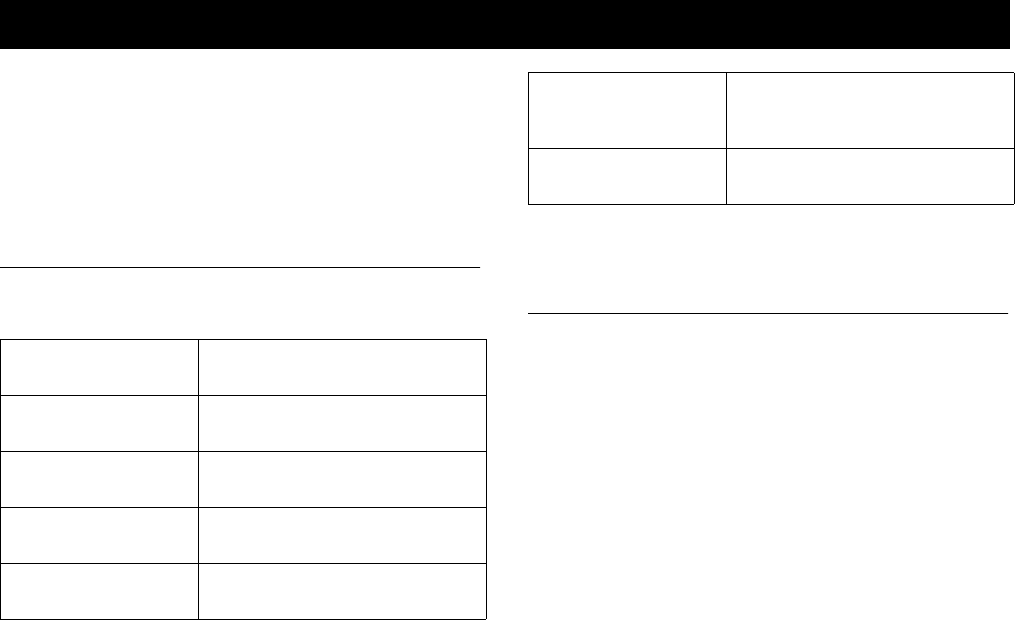
Some menus/features are operator dependent.
Call Information 47
During a call, the duration of the call is shown in the display. When
you end the call, the call duration information is shown for another
three seconds. If you subscribe to cost information, the call cost (or
the number of call units) is displayed instead of the call duration.
Note! Depending on whether a call is ongoing or not, the menus ‘Call Info’
and ‘Ongoing Call’ will replace each other.
Total Call Time or Call Cost
The Call Info menu allows you to check the total time or cost of
your calls.
Note! If you subscribe to cost information, you must enter your PIN2 to
clear the cost or time counter.
Determining the Call Cost
The Tariff function lets you enter and specify the price per call unit.
The price entered is stored on your SIM card.
Note! This service must be supported by your subscription and your net-
work.
If you do not specify a price per call unit, the number of call units is
displayed during a call, and in ‘Last call’ and ‘Tot al c ost’ in the ‘Call
Info’ menu.
Entering a Price Per Call Unit
Scroll to CALL INFO > YES >
Call Costs
> YES >
Set Tariff
> YES >
enter your PIN2 > YES > Select
Change Tariff >
enter the code for
the currency you want.
Tip! USD for US Dollar > YES > enter the price per call unit (for exam-
ple 0.75) > YES.
Call Information
Check duration of last call CALL INFO > YES >
Call Timers
> YES >
Last Call
>YES
Check cost of the last call. CALL INFO > YES >
Call Costs
> YES >
Last Call
> YES
Check time of outgoing
calls
CALL INFO > YES >
Call Timers
> YES >
Outgoing Time
> YES
Check total call time CALL INFO > YES >
Call Timers
> YES >
Tota l Ti m e
> YES
Check total call cost CALL INFO > YES >
Call Costs
> YES >
Tota l Co s t
> YES
Reset total call time CALL INFO > YES >
Call Timers
> YES >
Clear Timers
> YES > choose a timer to
clear
Reset total call cost CALL INFO > YES >
Call Costs
> YES >
Clear Total Cost
> YES > enter PIN2

Some menus/features are operator dependent.
48 Call Information
To enter the decimal point, press #.
To revert to call units
Scroll to CALL INFO > YES
>
Call Costs
> YES >
Set Tariff
> YES>
enter your PIN2 > YES > select
Units.
Credit Limit for Calls
If both your network and SIM card support this feature, you can
enter a total amount of money that can be used for making calls.
This could be useful when you lend your phone to someone and do
not want their call costs to exceed a certain amount which you can
decide. After a call is made, the cost is deducted from this amount.
When the amount reaches zero, no more calls can be made.
Note! As the price of a call may vary due to where you are calling from, at
what time of the day you are calling and so on, the credit limit is
only an estimated value.
Note! If you set the credit to Unlimited, the cost counter starts from zero
and increases.
Set a specific credit limit CALL INFO > YES >
Call Costs
> YES >
Set Credit
> YES > Enter PIN2 > YES >
Change Credit >
enter amount > YES
Set unlimited credit CALL INFO > YES >
Call Costs
> YES >
Set Credit
> YES > Enter PIN2 > YES >
Unlimited

Some menus/features are operator dependent.
Call Options 49
Call Forwarding
If you want to make certain that your incoming calls are correctly
handled when you are unable to answer them, you can use the For-
ward Calls service to forward them to another phone number.
If you subscribe to the Two Line Service, you may set different For-
ward Calls for your two voice lines (Line 1 and Line 2). You will
then have an additional forward alternative (All Line 2 Calls).
If you placed your phone in a specific Ericsson Desktop Charger,
your calls may be forwarded automatically.
When you are making a phone call and the phone call is forwarded
to another number, this is indicated in your display, if supported by
your subscription. Similarly, when receiving an incoming phone call
which has been forwarded from another number, this is indicated in
your display, if supported by your subscription.
Restrict Calls
A password, obtained from your network operator, is required to
activate call restriction.The following calls can be restricted.
•All Outgoing - all outgoing calls
•Outgoing Intl- all outgoing international calls
•Outg Intl Roam - all outgoing international calls except to your
home country
•All Incoming - all incoming calls
•Inc when Roam - all incoming calls when you are abroad (when
roaming),
Call Options
Activating Call
Forwarding
SETTINGS > YES >
Call Options
> YES >
Forward Calls
> YES > choose a
forwarding option >
Activate
> (the most
recently used number for the forward
function will appear) enter a new number,
if desired > YES
The forward calls icon will appear in
the display.
Canceling Call
Forwarding
SETTINGS > YES >
Call Options
> YES >
Forward Calls
> YES > select the option to
cancel > YES >
Cancel
Checking the Status of Call
Forward
SETTINGS > YES >
Call Options
> YES >
Forward Calls
> YES > select the option to
check > YES >
Get Status
Checking the Status of all
Forwarded Calls
SETTINGS > YES >
Call Options
> YES >
Forward Calls
> YES >
Check All
> YES
>
Cancel

Some menus/features are operator dependent.
50 Call Options
Note! If you forward incoming calls, you cannot activate some Restrict
Calls options. Likewise, if you restrict calls, you cannot activate some
Forward Calls options.
Fixed Dialing
The Fixed Dialing function allows calls to be made only to certain
numbers saved on the SIM card. If an attempt is made to call other
numbers, the message
Number not permitted
appears in the display.
Fixed Dialing requires a SIM card that allows fixed numbers to be
saved. The fixed numbers are normally protected by your PIN2. The
quantity of fixed numbers you can save depends on your SIM card.
It is possible to save partial numbers, for example an area code, or an
area code followed by the first digits common to several numbers.
Tip! Storing 919555 allows calls to be made to all numbers starting with
919555 Numbers beginning with the international (+) sign and
country code can also be saved, allowing you to make calls abroad.
Numbers which include question marks can be saved. A question
mark should be read as a wild card (it can represent any number 0-
9). To enter a question mark press and hold #.
Note! The Fixed Dialing service does not prohibit calls to the emergency
number 911(or international emergency number 112).
Activate Call Restrict SETTINGS > YES > Call Options >
YES > Restrict Calls >YES > select
type (activate, cancel, get status) > YES
Cancel All Restrict Calls SETTINGS > YES > Call Options >
YES > Restrict Calls >YES > Cancel
All > YES >enter password > YES
Check Status of Call Restrict SETTINGS > YES > Call Options >
YES > Restrict Calls >YES > scroll to
option > YES > Get Status > YES
Change Passwords SETTINGS > YES > Call Options >
YES > Restrict Calls >YES >Change
Passwd > YES > enter old password >
YES > enter new password > YES >
repeat new password> YES
Activate Fixed Dialing Phone Book > YES > Options > YES >
Fixed Dialing > YES > enter your PIN2 >
YES > select On/Off.
Save Fixed Numbers Phone Book >YES > Fixed Numbers >
YES > Add new?, YES > enter your PIN2
> YES > enter the fixed number > YES >
enter the name you want to associate with
the number > YES
Edit a Saved Fixed
Number
Phone Book > YES > Fixed Numbers >
YES > Edit > YES > scroll to the fixed
number that you want to edit > YES >
select Edit > enter your PIN2 > YES > edit
the fixed number > YES > edit the name >
YES > enter the position number > YES

Some menus/features are operator dependent.
Call Options 51
Closed User Groups
This feature limits outgoing calls to specified numbers. This can be
very useful when operators give lower rates for specific groups.
Note! The index numbers are provided by your network operator. Accept Calls
With the Accept Calls service, you can choose to receive calls only
from certain numbers. Other calls are automatically rejected by a
busy tone. You have to store the numbers that you want to receive in
an Accepted List. The rejected calls are saved in the Call List in the
CALL INFO menu. When you buy your phone, the setting for the
Accept Calls service is set to From All and you will receive calls as
normal. To change the Accept Calls options, follow this path and the
extension noted in the table.
Delete a Fixed Number Phone Book > YES > Fixed Numbers
>YES > scroll to the fixed number that
you want to delete > YES > select Delete >
enter your PIN2 > YES. The fixed number
is deleted.
Add a Closed User Group SETTINGS > YES > Call Options > YES
> Closed Groups > YES > Edit List >
YES > Add new? > YES >enter the
name of the group > YES > enter the
index number of the group > YES
Activate a Closed User Group SETTINGS > YES > Call Options > YES
> Closed Groups > YES > Edit List >
YES > scroll to the group > YES >
Activate > YES
Call Outside a Closed User
Group
SETTINGS > YES > Call Options > YES
> Closed Groups > YES > Open Calls
> YES> On
Edit a Name in the List SETTINGS > YES > Call Options > YES
> Closed Groups > YES > Edit List >
YES > scroll to the group to edit > YES
> Edit > enter a new name > YES
Delete a Group from the List SETTINGS > YES > Call Options > YES
> Closed Groups > YES > Edit List >
YES > scroll to the group to delete >
YES > Delete
Add New Numbers to List SETTINGS > YES > Call Options > YES
> Accept Calls > YES > Accepted List
>YES > Add new? > YES > select a
number from your phone book
Delete Numbers from the
List
SETTINGS > YES > Call Options > YES
> Accept Calls > YES > Accepted List
>YES > scroll to the number to delete >
press CLR > YES

Some menus/features are operator dependent.
52 Call Options
Activate the From List SETTINGS > YES > Call Options > YES
> Accept Calls > YES > Accepted List
>YES > select From list
Activate the From No One
Function
SETTINGS > YES > Call Options >
YES > Accept Calls > YES > Accepted
List >YES > select From No One
Activate the From All
Function
SETTINGS > YES > Call Options >
YES > Accept Calls > YES > Accepted
List >YES > select From All

Some menus/features are operator dependent.
Handling Multiple Calls 53
Note! Depending on whether a call is ongoing or not, the menus CALL
INFO and ONGOING CALL will replace each other.
The Call Waiting Service
If you wish to be able to receive a second call while another call is in
progress, you must turn on the
Call Waiting
service.
The
Call Waiting
service may not be available on all networks. If you
are engaged in a fax or a data call, you will not hear any incoming
calls. Incoming calls are rejected.
Receiving a Second Call
If the
Call Waiting
service is on, you hear a tone in the earpiece if you
receive a second call. The number or name of the caller is normally
shown at the top of the display together with a list of the alternatives
Answer, Busy
and
Release & Answer
. If the incoming call is a restricted
number, the display shows
Private.
Handling Multiple Calls
Activate Call Waiting SETTINGS >YES >
Call Options
>YES >
Call Waiting
>YES >
Activate
> YES
Cancel Call Waiting SETTINGS >YES >
Call Options
>YES >
Call Waiting
>YES >
Cancel
> YES
Check Status SETTINGS >YES >
Call Options
>YES >
Call Waiting
>YES >
Get
Status
>YES
Put Current Call on
Hold to Answer
Waiting Call.
Press
YES.Your held call is marked in
grey in the display and the
active call is marked in
black.
Reject Waiting Call Select
Busy.
If the caller’s network
supports it, the caller hears
a busy tone.
If
Forward When Busy
is
on, the waiting call is
forwarded to the number
you have specified.
End Current Call
and Answer Waiting
Call
Select
Release
& Answer.
You will now be connected
to the second caller.

Some menus/features are operator dependent.
54 Handling Multiple Calls
Note! You may also receive a third call. You must disconnect one of the
calls or create a conference call before you can answer the third call.
See “Conference Calls” on the following page.
Making a Second Call
Put the current call on hold by pressing YES > enter the number you
wish to call > YES.
Tip! You may also retrieve the number from your phone book by pressing
and holding .
Note! You can only put one call on hold.
One Active Call and One Call On Hold
When you have one active call and one call on hold, you can do one
of the following:
Conference Calling
A conference call is a call with more than two participants. As in an
ordinary conference, all participants can hear each other at the same
time. You may include up to five participants in a conference call.
To create a conference call, you must have one active call and one call
on hold.
ONGOING CALL > YES >
Join Calls
> YES.
Adding New Participants to the Conference Group
You may put the conference group on hold and then add new partic-
ipants.
Press YES to put the conference group on hold > Call the next per-
son you wish to include in the conference group > scroll to ONGO-
ING CALL > YES >
Join Calls
> YES.
You can include up to five participants in the conference group by
repeating process.
Checking the Participants in the Conference Group
ONGOING CALL
> YES >
Parties in Conf
> YES.
Switch Between the Two
Calls
YES.
End Active Call and Return
to Call on Hold
NO >
Retrieve call?
appears > YES. (If
you press NO, the call on hold will be
ended.)
End Both Calls ONGOING CALL > YES >
Release all
>
YES
Connect the two calls (Call
transfer)
ONGOING CALL
> YES >
Tra n s fer c al l
>
YES
Join Two Calls into a
Conference Call
ONGOING CALL > YES >
Join calls
>
YES

Some menus/features are operator dependent.
Handling Multiple Calls 55
The first participant’s phone number is displayed, if available. If the
participant’s number and name are stored in your phone book, the
name is displayed instead. Otherwise the display shows party 1, 2,
etc.
Scroll with or to check the other participants.
Having a Private Conversation with one Participants
If you wish to have a private conversation with one of the partici-
pants, you may extract that participant from the conference and put
the other participants on hold.
ONGOING CALL > YES >
Extract Part
> YES > select the participant
that you want to extract > YES.
To rejoin the participant to the conference group, scroll to ONGO-
ING CALL
> YES >
Join Calls
> YES.
Releasing Participants from the Conference Group
You can release participants from the conference group one by one or
all at once.
ONGOING CALL > YES >
Release Part
> YES > select the participant
that you want to release > YES.
To release all participants, scroll to
Ongoing Call
> YES >
Release All
>
YES.
Making a Call while a Conference Call Is in Progress
You can put the conference group on hold and make another call.
You can then switch between the new call and the conference call.
YES > enter the number you wish to call > YES
•Press YES to switch between the new call and the conference
group.
•Press NO and then YES to end the new call and return to the con-
ference group.
Ending the Conference Call
Press NO.
Using Two Voice Lines
If your subscription supports the Tw o Li ne Ser v ic e, your phone will
have two voice lines with different phone numbers, separate bills and
perhaps different subscription services. This is useful, for example, if
you want to keep business calls and private calls on separate lines.
When you buy your phone, the names of the lines are normally Line
1 and Line 2, but you can change their names. You can only send
text messages (SMS) on Line 1. An icon ( ) indicates the line
currently chosen for outgoing calls.
SETTINGS > YES >
Display
> YES >
Edit Line Tags
>YES > select a
line > enter a new name > YES.
Changing Phone Lines
Note! Incoming calls can be received on both lines, regardless of the line
currently chosen.
CALL INFO > YES >
Next Call
>YES > select
Switch to Line 1
(or
Switch to Line 2
).
From now on, all outgoing calls are made on this line.
Some menus/features are operator dependent.
56 Handling Multiple Calls
Note! Depending on whether a call is ongoing or not, the menus CALL
INFO and ONGOING CALL will replace each other.
Different Settings for Each Line
You may have different settings for each line, for example, the ring
signal or forward calls. You may also have separate voicemail num-
bers for each phone line, if supported by your subscription. Some
operators may show the call time or call cost for each line respec-
tively.
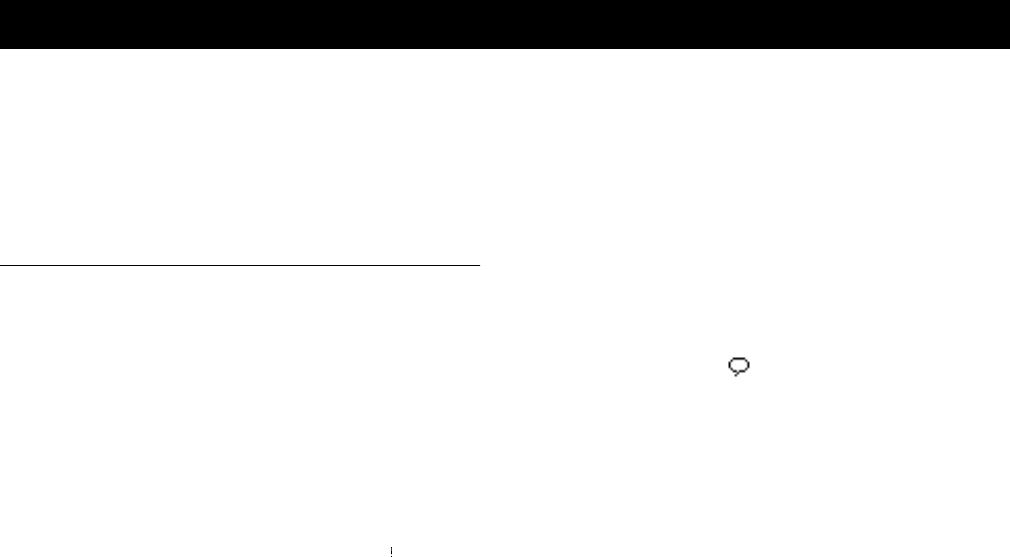
Some menus/features are operator dependent.
Voice Activation 57
The phone is equipped with a built-in voice recognition system
known as Voice Activation.
This system allows you to:
•voice dial - make calls
•voice answer - answer and reject calls
Voice Dialing
Activating the Voice Dialing function
PHONE BOOK > YES >
Options
> YES >
Voice Dialing
> On.
Recording Voice Dialing Labels
You can record (save) a voice label together with a name and number
in your phone book. The voice label and the name do not have to
match. That is, you can store a number with the name
Home
(that is
what you see in the display when searching for a number in your
phone book), but your voice label might be
Christina
. The voice
labels are stored on your phone.
Note! You will need to record new voice labels if you change phones or
SIM cards. The message
Voice Dial Error SIM Changed
will appear
when you insert a new SIM and attempt to activate the Voice Dial
feature.
If you insert a new SIM card and attempt to record a new voice label,
SIM changed! Erase all voice labels?
will appear. Press NO to keep the
original labels.
Note! Your phone can hold up to 10 different voice labels.
Adding a Voice Dialing Label to a Phone Book Entry
1 PHONE BOOK > YES >
Find and Edit >
YES
>
YES to see alphabet-
ical list (according to sort order) or enter the name.
2 Select the name you want to add a voice label to > YES.
3
Add voice
> YES.
4
After the Tone, Say the Name
appears.
Playing the Recording - Is it
Ok?
appears. Press YES to store or press NO to start over.
The voice label icon appears next to the position number.
Replacing or Erasing Voice Dialing Label
1 Scroll to PHONE BOOK > YES >
Voice Labels >
select a label to
erase or replace.
2 The name and number is displayed and the voice label is played.
3 Press
YES to select > select
Replace voice
or
Erase voice
> YES > fol-
low prompts.
Using Voice Dialing
Once you have recorded your voice labels and the Voice Dialing
function is on, you can start using the Voice Dialing system.
Voice Activation

Some menus/features are operator dependent.
58 Voice Activation
1 Clear the display using CLR.
2 Press and hold the YES key, or the press the upper side volume key
briefly
3 Say the voice label after the prompt.
Voice Label List
If the Voice Dialing function is on, the PHONE BOOK menu
includes a list of labels. When selected, you can scroll through the
names and numbers which have a voice label attached. When such a
number is displayed, its voice label is played back. You can call the
number by pressing YES.
PHONE BOOK > YES >
Voice labels
> scroll through the list to hear
the labels.
Voice Answering
Recording the Voice Answering Labels
Voice Answering
is only available when you are in handsfree mode. To
maximize sound quality, you should be attached to a handsfree
device when you are recording your voice answering labels. Be cer-
tain the
Voice Answering
option in the SETTINGS menu is acti-
vated.
Turning On Voice Answering
SETTINGS > YES >
Handsfree
> YES >
Voice Answering
> YES >
On
>
YES.
Creating Voice Answering Labels
The word that you choose to accept or reject calls can be any word in
any language, but the recording time is limited. Try to make the
words unique and not too short, such as
Answer
to accept and
Busy
to reject incoming calls.
1 Scroll to SETTINGS > YES
> Handsfree
> YES >
Voice Answering
>
YES > ON > YES.
2 Follow the phone’s prompts to add the voice answering labels. For
instance, say “Answer” for answering and “Busy” for rejecting.
Press YES when prompted to save your recordings.
Note! Be sure that you have two different words for accepting or rejecting.
Voice Answering
When you receive an incoming call, clearly say the voice command
that you have recorded.
Recording Problems
If the phone could not detect any speech, one of the following might
have happened:
•The name of the voice label was too short
•The background noise of your recording location was too loud
•You spoke too softly
•You spoke before the beep
•The label is too similar in sound to another label
Try to change one of these factors and repeat the steps in “Adding a
Voice Dialing Label to a Phone Book Entry.”

Some menus/features are operator dependent.
Calendar 59
The Calendar makes it possible for you to keep track of important
phone calls that you need to make or meetings that you need to
attend. You can also have the phone remind you before an appoint-
ment. In this way, you can be sure that you don’t miss anything
important, no matter where you are.
You can store three different types of appointments in your Calen-
dar:
•Meeting, including date and time, duration, subject, location and
a reminder.
•Phone call, including date and time, duration, what phone num-
ber to call, subject and a reminder.
•Reminders, including date, time and subject.
Adding a Meeting
1
Extras
> YES >
Calendar
> YES >
Add new
> YES.
2 Select
Meeting
> YES.
3 Enter the
Start date:
> YES.
4 Enter the
Start time:
> YES. (Use * to toggle between am/pm).
5 Use or to select the
Duration
time for the meeting. Use * to
select a duration.
6 Press
YES.
Note! The phone will alert you if you are scheduling a meeting that con-
flicts with another appointment.
7 Enter the
Subject
> YES. The phone will default to predictive text
input. See “Predictive Text Input” on page 34.
8 Enter the
Location >
YES.
9 Use or to select when to get a
Reminder
about the meeting.
Use * to select a reminder time.
10 Press YES. When the reminder has been stored, the display shows
New entry added
.
Adding a Phone Call
1
Extras
> YES >
Calendar
> YES >
Add new
> YES.
2 Select
Phone call
> YES.
3 Enter the
Start date:
> YES.
4 Enter the
Start time:
> YES. (Use * to toggle between am/pm).
5 Use or to select the
Duration
time for the meeting. Use * to
select a duration.
6 Press
YES.
Note! The phone will alert you if you are scheduling a meeting that con-
flicts with another appointment.
7 Enter the phone number of the person you are going to call. >
YES.
Calendar

Some menus/features are operator dependent.
60 Calendar
8 Enter the
Subject
> YES. The phone will default to predictive text
input. See “Predictive Text Input” on page 34.
9 Use or to select when you want your
Reminder
to sound or
appear. Use * to select a reminder time.
10 Press YES.
New entry added
appears.
Using the Phone Call Reminder Function to Place a Call
When you add a reminder to a phone call entry, the phone number
will appear along with the reminder. When setting the reminder,
choose
On Time
to have the reminder appear at the same time you
have scheduled the call.
1 When the reminder appears (or sounds), press YES.
2
Call?
will appear. Press YES to call the stored number.
Adding a Reminder
1
Extras
> YES >
Calendar
> YES >
Add new
> YES.
2 Select
Reminder
and then press YES.
3 Enter the
Start date:
and press YES.
4 Enter the
Start time:
and press YES.
5 Enter the
Subject:
and press YES.
When the reminder has been stored, the display shows
New entry
added
.
Using Your Calendar
Viewing Today’s Appointments
1
Extras
> YES >
Calendar
> YES >
View today
> YES.
2 Navigate through the appointments using or , or select
Add
new
to add a new appointment for today.
Viewing Weekly/Monthly Appointments
The weekly overview displays all your appointments during a certain
week. All your appointments are displayed as boxes, and the number
of the week is displayed in the top right-hand corner.
1
Extras
> YES >
Calendar
> YES >
Week view
/Month view > YES.
2 Use the keypad in the following ways:
•Use the side volume keys to jump from one day to another.
•Press 1 and 3 to jump a week backward or forward.
•Press 4 and 6 to jump a month backward or forward.
•Press 7 and 9 to jump a year backward or forward.
•Use or to move backward and forward within one day.
•Press CLR to return to today’s date in the month view. Press and
hold YES to jump to the weekly overview.
•Press YES to see daily overview.
Calling a Phone Number Stored in an Appointment
1
Extras
> YES >
Calendar
> YES.
2 Go to the day of the appointment in which the phone number is
stored, by selecting either
View today
,
Week view
or
Month view
.

Some menus/features are operator dependent.
Calendar 61
3 Scroll to the appointment and press YES and then YES again.
4 Select
Call
from the list.
Managing Your Calendar
Deleting Appointments
1
Extras
> YES >
Calendar
> YES.
2 Go to the day of the appointment you wish to delete by selecting
either
View today
,
Week view,
or
Month view
.
3
View today
> scroll to the appointment you wish to delete > CLR.
Note! In
Week view
and
Month view
: First select the day of the appointment
and then scroll to the appointment you wish to delete and press CLR.
Editing Calendar Appointments
1
Extras
> YES >
Calendar
> YES.
2 Go to the day of the appointment you wish to edit by selecting
either
View today
,
Week view,
or
Month view
.
3 Scroll to the appointment you wish to edit and press YES. Press
YES again.
4 Select
Edit
.
5 Enter the correct date and time. Press YES after each selection.
Note! If you do not want to change a part of an entry, for example, the
date, press YES and it remains the same. The entry has been success-
fully changed when you see the text
Saved
in the display.

Some menus/features are operator dependent.
62 Setting Network Preferences
When you turn on the phone, it searches for the last accessed net-
work. If this is not within range, you may use another network, pro-
vided your home network has an agreement that allows you to do so.
This is called
roaming
.
The order of preference in which the phone chooses a network is
determined by a list of preferred networks on your SIM card. Your
phone includes a number of functions that let you determine how it
searches for a network. You may also choose a network yourself from
those within range.
Display Information
The active network is marked with a filled button. The network
name and the following information is available in the display. Other
networks without icons are available.
Forbidden Networks
The names of the forbidden networks are stored on your SIM card.
If such a forbidden network is within range, it is left out when the
phone searches for a network (automatic search mode).
If your home network and a forbidden network come to an agree-
ment that allows you to use the forbidden network, you can select
this network even though the message
Forbidden
is displayed.
Setting Network Preferences
Selecting a Specific
Network
Settings
> YES >
Networks
>
YES >
Select
Network >
YES
If there is more than one network within
range, scroll to the network you want and
press YES to select it.
Automatic Search
Settings
> YES >
Networks
>
YES >
Search
Mode
> YES
The phone automatically starts searching
for a network according to the list of
preferred networks stored on your SIM
card.
Preferred
network
indicator
Indicates that a network is
preferred and can be used.
Forbidden
network
indicator
Indicates that a network is
forbidden and cannot be used.
Home network
indicator
Indicates that your network is
within range and can be used.

Some menus/features are operator dependent.
Setting Network Preferences 63
List of Preferred Networks
You can create and edit a list that defines which order your phone
will select a network during automatic network selection, when your
home network is not within range. The number of networks that can
be stored in the list depends on your SIM card.
You can review the network list and rearrange the order of the net-
works. You can also add new networks to the list and delete networks
from it. Follow this path and the extensions noted below.
Search Modes
Automatic search mode
means that your phone searches for the last
accessed network first. If this is not available, it automatically
searches for another available network within range.
Manual search mode
means that your phone searches for the last
accessed network first. If this is not available, the question
Select net?
appears. You then need to choose a network as described on the pre-
vious page.
Review list SETTINGS > YES >
Networks
> YES >
Preferred Nets
> YES > scroll with or
View network name SETTINGS > YES >
Networks
> YES >
Preferred Nets
> YES > scroll to network
name > YES >
Full Name
Delete a network SETTINGS > YES >
Networks
> YES >
Preferred Nets
> YES > scroll to the
network to delete > YES >
Delete
.
Rearrange the list SETTINGS > YES >
Networks
> YES >
Preferred Nets
> YES > scroll to the
network to move > YES >
Change Priority
> enter new position > YES
Add a network SETTINGS > YES >
Networks
> YES >
Preferred Nets
> YES >
Add new?
> YES >
scroll to the network to add > YES* >
enter a position number > YES.
*If the network you want does not appear
in the list, scroll to
Other
and press YES.
Enter the three-digit country number and
the two-digit network number and press
YES. All lower prioritized networks will be
shifted one step down in the list.
Automatic Search
Settings >
YES >
Networks
> YES >
Search Mode
> YES >
Automatic
>YES
Manual Search
Settings
>
YES
>
Networks
>
YES
>
Search Mode
>
YES
>
Manual
>
YES

Some menus/features are operator dependent.
64 Security
This icon indicates ( ) that either SIM Card Lock or Phone Lock
is activated.
SIM Card Lock
The SIM card lock only protects your subscription and not your
phone itself from unauthorized use. If you change SIM cards, the
phone still works with the new SIM card. Most SIM cards are locked
at the time of purchase. If the SIM card lock is on, you have to enter
the PIN every time you turn on your phone.
Note! If you enter your PIN incorrectly three times in a row, the SIM card
is blocked. This is indicated by the message
PIN blocked
. If this hap-
pens you need to unblock it to access your subscription. If you enter
the wrong PUK 10 times in a row, your card is permanently blocked.
If this happens, you should contact your network operator.
Note! If the message
Codes do not match
appears, this means you entered
the new PIN incorrectly. If the message
Wrong PIN
appears, followed
by
Old PIN:
, you entered your old PIN incorrectly.
Phone Lock
The phone lock protects the phone against unauthorized use if it is
stolen and the SIM card is exchanged. It is not on when you buy the
phone. You can change the phone lock code (0000) to any 4- to 8-
digit personal code.
The phone lock can be
On, Automatic,
or
Off
.
Phone Lock On
If the phone lock is
On
, the message
Phone locked Phone lock code:
appears each time you turn on the phone. You have to enter your
code followed by YES to use your phone.
Security
Unblock SIM Card
PIN blocked
appears > enter your PUK
(or PUK2) which you will find in the
information supplied by your network
operator > YES > enter a new four- to
eight-digit PIN (or PIN2) > YES > re-
enter the new PIN (or PIN2) to
confirm > YES.
Change PIN SETTINGS >YES >
Locks
> YES >
Card
Lock
> YES >
Change PIN
(or
PIN2
) >
YES >enter the old PIN* > YES > enter
the new PIN > YES > repeat new PIN >
YES.
Turn Off/On SIM Card Lock SETTINGS >YES >
Locks
> YES >
Card
Lock
> YES >
Protection
> YES >
Off
(or
On
) > YES >
Enter PIN2
> YES.

Some menus/features are operator dependent.
Security 65
Automatic
If the phone lock is set to Automatic, you do not need to enter your
phone lock code until a different SIM card is inserted in the phone.
After the phone lock code has been entered correctly, the phone can
be used with the new SIM card. You are not asked to enter the phone
lock code again until the original SIM card or a different SIM card is
inserted.
Keypad Lock
This icon indicates the keypad is locked.
Note! Calls to 911 (or112, the international number) can be made when
the keypad is locked. If the phone alarm rings, you can turn it off by
pressing any key.
The keypad remains locked until you:
•answer an incoming call.
•replace the battery.
•unlock the keypad.
Manual Keylock
Automatic Keylock
Automatic keylock means that if no keys are pressed in 25 seconds,
the keypad will be locked. The keypad lock is always disabled if the
phone is connected to vehicle handsfree equipment.
SETTINGS > YES > Locks > YES > Auto Keylock > YES > On > YES.
Changing the Phone Lock
Code
SETTINGS > YES >
Locks
> YES >
Phone
Lock
> YES >
Change Code
> YES > enter
the old code > YES > enter the new code >
YES > repeat new code > YES.
Setting the Phone Lock SETTINGS > YES >
Locks
> YES >
Phone
Lock
> YES >
Protection
> YES > select
On
/
Automatic/Off
(the current selected setting
is not available in the list) > enter the
phone lock code > YES (the new lock
status
is shown).
Lock Keypad From Standby, press and hold CLR > 2 to
select
Keylock On
> YES.
Unlock Keypad From Standby, press and hold CLR >
Keylock off
> YES.

Some menus/features are operator dependent.
66 Extras
Alarm Clock
The phone has an alarm clock, which you may find useful when
traveling. When it is on, an icon is shown in the display.
The alarm rings at the time set and the display flashes, even if the
phone is turned off. The volume of the alarm signal is always increas-
ing, provided the battery is attached and charged.
The alarm rings for 60 seconds and is repeated every nine minutes, if
you do not turn it off. After 60 minutes, the repeat function is
turned off automatically.
Calculator
The phone has a built-in calculator, which can add, subtract, divide
and multiply. EXTRAS > YES >
Calculator
•Press # to get
+
,
-
,
x
,
/
.
•Press CLR to erase a figure to the left of the cursor.
•Press * to enter a decimal point.
Using the Calculator
In this example we are going to divide 134 by 32.
Tip! EXTRAS > YES >
Calculator
> YES > enter 134 > press # repeatedly
until the division sign (/) appears > enter 32 > YES to get the answer.
To clear the display, press CLR.
Games
Your phone has four different games for your enjoyment. There are
help texts available in each game as a guide for you to get started.
The following games are available:
•Tetr is®
•Solitaire
Extras
Set the Alarm EXTRAS > YES >
Alarm Clock
> YES >
enter the time > YES.
Change Alarm EXTRAS > YES >
Alarm Clock
> YES >
Set New Time
> YES > enter the time >
YES.
Tur n Al a r m Of f Wh e n it
Rings
Press any key to turn the alarm off
when it rings.
If you do not want the alarm to be
repeated, press YES
Tur n Al a r m Of f EXTRAS > YES >
Alarm Clock
> YES >
Select
Cancel
.

Some menus/features are operator dependent.
Extras 67
•Maze
•Erix
Tetris®
The object of Tetris is to prevent the blocks from reaching the top.
Each time you fill a line, the line disappears.
EXTRAS > YES >
Games
> YES >
Tetris
> YES.
Tetr i s
appears in the display > select
Start
> select level (1–10) by
using or > Press any key to start.
Controlling the game
•Press 8 or the lower side volume key = move left
•Press 2 or the upper side volume key= move right
•Press 5 or 9 to rotate
•Press 3 or 6 to drop faster
•Press CLR to pause
•Press NO to quit
Tetris®; © Elorg 1987. Classic Tetris™; © Elorg 1998
Tetris Logo by Roger Dean, © The Tetris Company 1997
All Rights Reserved
Solitaire
The object of Solitaire is to form four piles of cards, one per suit,
running from ace to king. The cards are dealt out into seven col-
umns. The last six columns have one or more cards facing down-
ward. If the top card in a column is removed, revealing the face-
down card, you may turn it face up. Only kings, or stacks of cards
beginning with a king may be moved to an empty column.
Columns of cards are built up in descending order and alternating
color. For example, the eight of hearts may be placed on either the
nine of clubs or spades.
The remaining cards in the deck are available for play. You can turn
these cards one at a time. The card in the discard pile may be placed
on the columns or the ace piles. When you run out of cards in the
deck, you can flip it over and continue.
EXTRAS > YES >
Games
> YES >
Solitaire
> YES.
Solitaire
appears in the display > to start a game select
New game
(or
Resume game
if you have played before).
Instead of choosing Start you can scroll with or to select
Resume game or Help (at step 2 above).
Controlling the game
•Press 1 to select card/pile, confirm move, clip card
•Press 2 to turn up new card from game deck
•Press 3 to put card on ace pile
•Press 4 to view a pile (selection and move is possible)
Maze
The objective of Maze is to eat the items in the Maze while avoiding
the monsters. Once accomplished, the degree of difficulty will
increase.
EXTRAS > YES >
Games
> YES >
Maze
> YES > YES to start game
Controlling Maze
•Press or to change selections (help, game difficulty, etc.)
•Press CLR to pause the game.

Some menus/features are operator dependent.
68 Extras
•Press 2 to move up
•Press 8 to move down
•Press 6 to move right
•Press 4 to move left
Erix
The objective of Erix is to isolate the bouncing objects into as small a
space as possible. You will draw lines to reduce the playing space.
The percentage of space to isolate is displayed in the top corner of
the screen. Once accomplished, the degree of difficulty will increase.
EXTRAS > YES >
Games
> YES >
Erix
> YES > YES to start game
Controlling Erix
• or to change selections (help, game difficulty, etc.), to move
left and right within the game.
•Press CLR to pause the game.
•Press 2 to move up
•Press 8 to move down
•Press 6 to move right
•Press 4 to move left
Timer
The phone has a built-in 24-hour timer. You set the time you want
and when that time is out, an alert signal sounds.
Setting the Timer
EXTRAS > YES >
Timer
> YES > enter the hours, minutes and sec-
onds > YES.
The countdown begins. The timer is shown in standby mode.
When the alert sounds, press any key to turn it off.
Setting a New Time When the Timer is Running
EXTRAS > YES >
Timer
> YES >
Set New Time
> YES > enter the
time > YES.
The countdown begins. The timer is shown in standby mode.
When the alert sounds, press any key to turn it off.
Turning Off the timer
E
XTRAS
> YES >
Timer
> YES > select
Cancel
.
Note! The timer does not work when the phone is turned off.
Stopwatch
The phone has a built-in stopwatch for you to time a certain activity.
Running the Stopwatch
EXTRAS > YES >
Stopwatch
> YES > YES to start the stopwatch >
YES again to stop it.
Resetting the Stopwatch
Press CLR when the stopwatch is not running.
Note! By pressing # when the stopwatch is running, you can store up to 9
lap times. Press or to check your stored lap times. If you receive
Some menus/features are operator dependent.
Extras 69
an incoming call or voice or text message while the stopwatch is run-
ning, the stopwatch is turned off. If you exit the stop watch menu
the stop watch is turned off.

Some menus/features are operator dependent.
70 Online Services
Online Services
The Online Services is the network operators’ way of offering cus-
tomized services, independently of mobile phones and mobile phone
manufacturers.
Compatibility
Added value services based on the
Online Services
require two things
in order to work:
•a mobile phone that supports the
Online Services.
Your Ericsson phone is such a phone.
•a network operator offering the
Online Services
.
Note! The Online Services on the SIM are designed and run by network
operators and not by mobile phone manufacturers. If you require
further information about the Online Services, please contact your
network operator.
New Menu
A SIM card which supports the
Online Services
works in the same
way as a normal SIM card.
When you have inserted your SIM card and turned on your phone,
your network operator may download data to your SIM card. After
the first data download and after restarting your phone, the proactive
SIM offers a new menu in the phone. The menu offers you new fea-
tures and services, which can be used instantly.
In your phone, this menu appears under the
Extras
menu. There can
only be one new submenu entry under the main menu, but there can
be several submenus under the new submenu entry.
Entering your New Menu System
1 EXTRAS > YES >
Online Services
> YES.
If any submenus appear, select the one that you want and press
YES.
2 Press NO to go back to the standby menu.
Note! Some operators may not use the name Online Services for this
menu. Please consult your network operator for more information.
Proactive SIM
The
Online Services
provides a proactive SIM. This means that the
SIM can tell the phone to take certain actions. These actions could
include:
•Showing text from the SIM in the phone’s display
•Setting up a call to a number on the SIM
•Initiating a dialog with the user
Online Services

Some menus/features are operator dependent.
Online Services 71
Note! All these actions are taken by the SIM card and have nothing to do
with the phone’s software.
Data Download to the SIM Over the Air
Your network operator may at any time download new data to your
SIM card over the air. This new data could consist of new features or
a new menu.
Resetting your SIM Card
When the operator updates your SIM card over the air, the phone
notifies you by showing a message in your display. You also hear a
beep.
In order for your new SIM settings to take effect, you have to turn
off your phone and then turn it on again.
Note! After a data download the phone may not work and you will not be
able to use it until you restart it. This feature is operator dependent
and will probably not happen very often.
SIM Card Initiated Features
Note! Some SIM cards may not allow certain numbers to be processed
through your network. You will receive a message from the phone
that the call is not possible or is not allowed. Refer to your provider
for more details.
The SIM card may prompt you to make a call. This could happen
even if you are already engaged in a call.
When this happens, the phone will notify you by producing a sound
and showing a message in the display.
•If you are not engaged in a call, a message is shown in the display,
asking you whether you want to confirm and make the SIM card
initiated call.
If you want to make the SIM card initiated call, press YES.
If you do not want to make the SIM card initiated call, press NO.
•If you are already engaged in a call, you are asked either to put the
current call on hold or to end it.
A message appears in the display, asking you whether you want to
confirm and make the SIM card initiated call.
If you want to make the SIM card initiated call, press YES.
If you do not want to make the SIM card initiated call (you may
want to continue with the ongoing call), press NO.
Sending a SIM Card Initiated SMS
The SIM card may set up an SMS (text message) and ask you to send
this message, for example by the question
Send message now?
Press
YES if you want to send the SMS.
Details of Services Offered
All services and functions that come with the
Online Services
are net-
work dependent. Please contact your network operator for details of
services offered by the
Online Services.

Some menus/features are operator dependent.
72 Online Services
Ericsson Mobile Internet
When you are on the move and in need of communication and
information, the
Mobile Internet
is the answer.
The
Mobile Internet
is a service supplied by Ericsson to make it easier
for you to communicate and receive information quickly, wherever
you are. It gives you access to various messaging services, on-line cus-
tomer services, user manuals and other useful information. With the
Mobile Internet
you can also download communications software to
ensure you get the best out of your Ericsson products.
The Ericsson Mobile Internet address is:
http://mobileinternet.ericsson.com

Some menus/features are operator dependent.
Using the WAP Browser 73
Examples of WAP SERVICES you will be able to find are:
•Ericsson Mobile Internet (
http://mobileinternet.ericsson.com)
a por-
tal offering you online access to customer services, user’s guides,
and useful information when you are traveling
•Reservation services
•News, sports, and weather
•Restaurants, cinemas, games, etc.
•Banking and stock exchange quotes
•Voice mail, e-mail, and fax mail
Terminology
In this chapter and in the WAP Services menu, you will see many
new terms. Here is a brief description of some of the terms that may
appear.
WAP -
Wireless Application Protocol. A standard created specifically
for mobile communications devices that gives you fast and easy
internet access from your phone.
Gateway Address
- The SMS Gateway access number to your network
operator’s WAP gateway. Contact your service provider if this infor-
mation is not stored in your WAP Services settings.
Bookmark
- Like any Internet browser, your phone has the capability
to store your favorite bookmarks.
Homepage
- The page your phone will default to when you begin
browsing. Each profile has its own homepage.
Profile
- Customized settings to simplify browsing. Each profile has
its own settings such as gateway number, homepage, password, and
name.
Before You Start
Make sure the WAP settings in your phone are correctly set. Your
operator should provide you with all the necessary information when
you sign up for your subscription to the WAP service: for example
user name and gateway address. These settings can either be entered
in your phone at the time you buy it, or later via an SMS sent to
your phone. See “Changing the WAP Settings Manually” on
page 77.
Note! Please contact your network operator before you decide to change
the settings manually. This way you can be sure the entered settings
are correct.
Setting Up Your WAP Connection
1 WAP SERVICES > YES >
WAP Settings
>YES > select a profile > YES
>
Gateway
> YES >
User ID
> YES.
2 Enter the user id to your gateway > YES.
Using the WAP Browser

Some menus/features are operator dependent.
74 Using the WAP Browser
3 Select
Password
> YES > enter the password to your gateway >
YES.
4 Select
Gateway
> YES > enter the phone number to your gateway >
YES.
5 Press NO to return to
Profile
submenu > select
Service Center
> YES
> enter the phone number to your service center > YES.
Viewing a WAP Page
You can open WAP pages in three different ways:
1 Open your homepage
2 Open a bookmark
3 Enter a WAP address manually
If your network operator has entered its own page into your WAP
SERVICES menu, you can also start the browser by selecting this
address. See “Operator Page” on page 76.
This animation will appear when your phone is searching for, or
connecting to, a WAP site.
Note! WAP Browser - Your phone uses SMS (Short Message Service) as a
bearer for WAP. Not all network operators support WAP over SMS.
For more information, please contact your operator.
Opening Your Homepage
WAP SERVICES > YES >
Mobile Internet
(this will change depending
on which profile you have selected) > YES.
Opening a Bookmarks
Adding a bookmark
Note! You can only add bookmarks while you are browsing.
1 Scroll to
WAP SERVICES > YES.
2 Start your browsing by selecting either
Mobile Internet
,
Bookmarks
or
Enter address
.
Read more about how to use these menus in the rest of this chap-
ter.
3 Find the WAP page that you want to bookmark. Press and hold
YES until options appear.
4 Scroll to the submenu
Add bookmark
and press YES. If there are
any empty positions left in your bookmark list (you can save up to
10 bookmarks), your new bookmark is stored. If your bookmark
list is full, you have to delete another bookmark before you can
save the new one.
5 Your new bookmark has been saved when you see the text
Book-
mark stored
.
Opening a Bookmark While Browsing
1 While browsing, press and hold YES until
Options
appears.
2
Go to
> YES >
Suspend
> YES >
Bookmarks
> select the bookmark
to open > YES >
Go to
> YES.
Deleting a Bookmark
You can store a maximum of 10 bookmarks. If you have reached this
limit, you can delete some of the bookmarks that you do not use any
more.

Some menus/features are operator dependent.
Using the WAP Browser 75
WAP SERVICES > YES >
Bookmarks
> YES > select the bookmark you
wish to delete >
Delete
>
Delete?
appears
>
YES.
Editing a bookmark
1 Scroll to WAP SERVICES > YES >
Bookmarks
> YES.
2 Select the bookmark you wish to edit > YES.
3 Select
Edit.
4 Under the heading
Title:
, use the or keys to move within the
title of the bookmark. Enter the correct name of the bookmark
and then press YES.
5 Under the heading
Address:
, use the or keys to move within
the address. Enter the correct address and then press YES.
Sending a bookmark to another person via SMS
1 Scroll to WAP SERVICES > YES >
Bookmarks
> YES.
2 Select the bookmark you wish to send and press YES.
3 Select
Send as link
> YES > enter a message following the link >
YES.
4 Enter the recipient’s phone number or retrieve it from the phone
book by pressing .
5
Sending message
appears in the display followed by
Message has
been sent
.
Note! To send the bookmark you are currently visiting in the browser:
open the
Options
menu by pressing and holding YES and then select
Send as link.
Manually Opening Websites
1 Scroll to WAP SERVICES > YES >
Enter Address
> YES.
2 Enter the URL address of the WAP page you want to go to, for
example: http://mobileinternet.ericsson.com
3 Press
YES.
Note! Forward slashes (
//
) and the
@
symbol can be accessed with the 0
key. Periods (.) can be accessed with the 1 key.
If the WAP address starts with http://, you do not need to enter this
prefix. You only need to enter the prefix if it starts with something
else, for example, ftp://.
Profiles
Your phone comes with three WAP profiles to assist in simplifying
browsing. You can, for example, associate one profile to your opera-
tor’s WAP page and one to your company’s intranet. Instead of hav-
ing to enter the access settings, when you want to switch between
your operator’s WAP page and your company’s intranet, you can
simply switch profiles. It is important to remember two things about
the WAP profiles:
•You can set different homepages for each WAP profile. When you
switch profiles, the homepage changes to the homepage set for
that profile.
•A saved bookmark may not work with all WAP profiles. When
you save a bookmark, it is associated with the WAP profile that
you are currently using. If you cannot access a bookmark, you may

Some menus/features are operator dependent.
76 Using the WAP Browser
solve the problem by switching profiles and then accessing the
bookmark again.
Selecting a Profile
WAP SERVICES > YES >
Wap Profile
> select a profile by pressing * >
YES.
The homepage associated with this profile will now be the homepage
listed under the WAP Services menu.
Renaming a Profile
WAP SERVICES > YES >
Wap Settings
> select a profile >
Rename
>
enter the new name > YES to store.
Changing the Profile Homepage Name and Address
WAP SERVICES > YES >
Wap Settings
> select a profile >
Chg
Homepage
> enter the new title for the homepage > YES to store >
enter the new address > YES to store.
Operator Page
Depending on the network, you can find the homepage of your net-
work operator.
1 Scroll to
WAP SERVICES
> YES > select your operator’s page (the
name is decided by your operator) > YES.
2 Your operator’s WAP page appears.
Note! If you cannot find this menu, your network operator does not sup-
port this service.
Your Browsing Options
When you are browsing a WAP page, you can access the Options
menu. The options you can choose from this menu are supplied with
the pages, and therefore the menu may look a bit different depend-
ing on which page you are looking at. Generally, on the Options
menu you can also find functions that are useful when browsing.
You can reach the
Options
menu in two ways:
•No matter where you are browsing, press and hold YES until the
Options
menu appears.
•Scroll to an area on the WAP page that does not contain any links,
phone numbers or e-mail addresses and press YES. You can always
find an empty row at the bottom of the WAP page.
The Options Menu
The
Options
menu may look a bit different depending on which
page you are looking at, because it can contain special features. How-
ever, it always contains the options below:
•
Suspend.
Go back to the WAP SERVICES menu where you can
access your bookmarks among other things.
•
Reload
. Get the latest version of the WAP page by refreshing its
content.
•
Add bookmark.
Add the page you are currently browsing to your
list of bookmarks.
•
Send as link
. Send the current page as a bookmark to another
phone via SMS.
•
New homepage
. Set the current WAP page as your homepage.
•
Exit
the browsing session.

Some menus/features are operator dependent.
Using the WAP Browser 77
Displaying Images
You can choose whether you want to see images or not when you are
browsing. The images take extra time to download, but the WAP
pages looks better with them. When you buy the phone, the image
load is set to
On
.
Scroll to WAP SERVICES > YES > WAP
Settings
> select a profile > YES
>
Image Load
> YES >
On
/
Off
> YES.
Note! If you have turned off the image load, the images are displayed as
icons in the display. If a picture contains a link, you can access this
link by highlighting the image and pressing YES.
Returning to the Browser after Accessing the
Menus
If you have selected the option Suspend in order to access the WAP
menu, you can easily return to the site you were visiting when you
left the browser.
1 Scroll to
WAP SERVICES > YES >
Resume
> YES.
2 You return to the beginning of the WAP site where you were when
you left the browser.
Note! You will end up at the first page of the site, even if you were in the
middle of it when you left the browser.
Changing the WAP Settings Manually
Note! Please contact your network operator before you start changing the
settings manually. This way you can be sure the entered settings are
correct.
Setting Your User Information
When you start your browsing session, your phone connects to a
network computer. In order for this network computer to establish a
connection to your phone, you need to enter your user ID (user
identification), password, IP address and the phone number to your
gateway.
1 Scroll to
WAP SERVICES > YES > WAP
Settings
> select a profile >
YES >
Gateway
> YES >
User ID
> YES.
2 Enter your user ID and press YES.
3 Scroll to
Password
and press YES. Enter your password and press
YES.
4 Scroll to
Gateway
and press YES.
5 Enter access number to the SMS WAP Gateway you should con-
nect to when browsing.
6 Press
YES.
Download Time Out
When you try to access some WAP pages, you may have to wait for a
long time while your phone tries to download the page. You can set
the time that will pass before the download attempt is stopped.
1 Scroll to
WAP SERVICES > YES > WAP
Settings
> YES > select a pro-
file >
Response Timer
>YES.

Some menus/features are operator dependent.
78 Using the WAP Browser
2 Enter after how many seconds you want the download to continue
before it stops. Press YES.
Hardware Reset Button
If you are browsing and need imme-
diate access to phone mode, you can
reset the phone by pressing the
hardware reset button. To access the
button, you must remove the back
panel and the battery.
Note! You will need to power on the
phone after pressing the reset but-
ton. Your connection to the web will
be lost until you reconnect.

Some menus/features are operator dependent.
Troubleshooting 79
This chapter lists some problems that you might encounter while
using your phone. Some problems require that you call your service
provider, but most of the problems you encounter you can easily cor-
rect yourself.
Error Messages
Insert Card
There is no SIM card in the phone or you may have inserted it incor-
rectly. Insert a SIM card. See “Step 2: Insert the SIM Card” on
page 14.
Insert Correct SIM Card
The phone is set to only work with certain SIM cards. Insert the cor-
rect SIM card.
SOS Calls Only
You are within range of a network but you are not allowed to use it.
However, in an emergency, some operators allow you to call the
international emergency number 112 (or 911). See “Making Emer-
gency Calls” on page 22.
No Network
There is no network within range or the received signal is too weak.
You have to move to get a signal that is strong enough.
Wrong PIN, Wrong PIN2
You have entered your PIN or PIN2 incorrectly. Enter the correct
PIN or PIN2, and press YES. See “SIM Card Lock” on page 64.
Codes do not match
When you want to change a security code (for example your PIN)
you have to confirm the new code by entering it again. The two
codes that you have entered do not match. See “SIM Card Lock” on
page 64.
PIN/PIN2 Blocked
You have entered your PIN or PIN2 incorrectly three times in a row.
To unb loc k, see “SIM Card Lock” on page 64.
PUK blocked- Contact operator
You entered your personal unblocking key code (PUK) incorrectly
10 times in a row. Contact your network provider or service opera-
tor.
Phone Locked
The phone is locked. To unlock the phone, see “Phone Lock” on
page 64.
Phone lock code:
Your phone comes with the phone lock code, 0000. You can change
it to any four-to eight-digit code. See “Phone Lock” on page 64.
Troubleshooting

Some menus/features are operator dependent.
80 Troubleshooting
Number not permitted
The Fixed Dialing function is on and the number you have dialled is
not part of your fixed numbers list. See “Fixed Dialing” on page 50.
Charging, alien battery
The battery you are using is not an Ericsson-approved battery and is
charging slowly for safety reasons.
Other Problems
No Indication of Charging
When you start charging a battery that is empty or a battery that has
not been used for a long time, it make take a while until the indica-
tor on the top of the phone shows a red light and the battery meter
appears.
Network is not responding in WAP mode
If you are using WAP services and need immediate access to phone
mode, you can press the Hardware Reset button (located under the
battery). You may need to power on your phone before making a
call.
The Phone Cannot Be Powered On
Recharge or replace the battery. See “Step 3: Attach the Battery” on
page 15.
Accessories, Accessibility, and Internet
Technical Assistance/Ordering Accessories
•North America - 1-800 ERICSSON (1-800-374-2776)
•Latin America - 305-755-6789
•Other countries - 919-472-7908
Accessible Solutions/Special Needs
For information on Accessible Solutions for individuals with special
needs call the Ericsson Special Needs Center at 877-878-1996
(TTY) or 877-207-2056 (voice), or visit the Ericsson Special Needs
Center at http://www.ericsson-snc.com
Internet
Visit Ericsson on the internet at: http://www.mobile.ericsson.com

Some menus/features are operator dependent.
Index 81
A
Accept Calls51
Accessible Solutions80
Accessories
adding to profiles29
Advice of Charge10
Alarm66
Alarm indicator18
Alternate Line Service10
Answering Calls23
Area Information1045
message types45
receiving area messages45
Ask to Save10
Assembling the Phone13
B
Banking by phone33
Battery
attaching15
charging15
meter17
removing15
Bell. See Alarm indicator
Browser73
C
Calculator66
Calendar1059
storing general reminders59
storing meetings59
storing phone calls59
weekly overview60
Call
restricting49
Call Cost
setting a credit limit48
specifying price per unit47
Call Forward
indicator17
setting49
Call Waiting53
Calling Cards
making a call37
saving number37
services37
Calling Line Identification (CLI)35
Calls
adding to calendar59
answering23
forwarding49
putting on hold2354
receiving23
redialing22
rejecting23
CB. See Area Information
Cell Broadcast. See Area Information
Changing Phone Lines55
Charger16
Ciphering Indictor18
Closed User Group1051
Conference Calls54
Contacting Ericsson80
Copying SIMs32
Credit Cards
making a call37
saving a number37
D
Demonstration10
DTMF tones24
E
Emergency Calls22
Error messages79
Extras66
Index
Some menus/features are operator dependent.
82 Index
F
Find and Call31
Fixed Dialing1050
Forwarding Calls1049
G
Games1166
H
Help Texts11
Homepage74
I
Infrared Modem Indicator18
International Calls22
International Emergency Number22
Internet Access73
K
Keylock Indicator18
L
Letters, entering34
Line indicator18
Locks
keypad65
phone64
SIM, phone64
M
Missed Call Indicator17
Missed Calls36
Mobile Internet73
Mobile Wiz11
Muting microphone23
My Shortcuts20
N
Network
forbidden networks62
preferred networks63
search modes63
Note Pad24
O
Online Services1170
P
Personal ring signal25
Phone Book11
checking status of memory34
e-mail addresses34
entering letters34
erasing phone number32
groups33
international numbers30
keeping up to date31
memory full32
shortcuts31
Phone Lock
auto lock65
full lock64
Phone Number in SMS44
PIN1664
Predictive Text Input34
Proactive SIM70
Profiles1128
auto activation29
changing settings28
choosing manually28
indicator18
PUK64
R
Receive Calls23
Receiving messages (SMS)43
Redialing Numbers22
Rejecting Calls23
Request reply (SMS)42
Restrict Calls49
Ring Signal
choosing25
composing own26
off18
personal25
volume25
Ringer Volume25
Some menus/features are operator dependent.
Index 83
S
Security1264
Sending Messages (SMS)41
Short Message Service12
Shortcuts20
Signal Strength Indicator17
Silent Mode25
Silent Mode Indicator18
SIM
card14
data download to71
features initiated by71
inserting14
proactive70
removing14
resetting71
SMS12
composing messages41
deleting a message44
embedded numbers44
enabling phone for sending41
indicator18
message types42
reading stored messages44
receiving messages43
reply requested42
sending messages41
storing messages44
templates1242
Special Characters34
Special Needs80
Speed Dialing31
Stopwatch1268
Stored Messages (SMS)44
T
Technical Support80
Tegic® T9®11
Telephone Banking33
Text
input11
messages (SMS)12
Timer66
Tone Signals24
Touch tones24
Troubleshooting79
TTY Phone Number80
Turning Your Phone On16
Two Line Service55
V
Voice Label
icon57
recording57
Voice Labels12
Voice Recognition12
Voicemail12
calling39
changing number39
indicator18
Volume
changing23
W
WAP1273
Some menus/features are operator dependent.
84 Index

Storing Numbers in Phone Book:
Enter phone number > PHONE
BOOK >YES > Add Number > YES >
YES to select number > enter name >
YES to select next available position.
Adding a Voice Label to an Existing
Phone Book Entry: Scroll to
PHONE BOOK > YES > Find and
Edit > enter the name or press YES
again to view the entire list > Add
voice > Follow the prompts to record
and store.
Emergency Calls: Enter 911 (or
112) and press YES to call.
Handling Multiple Calls: When on a call,
scroll to HANDLE CALLS. Use this
menu to initiate conference calls, to toggle
between several calls, and transfer calls.
Setting the Alarm: EXTRAS > Alarm
Clock > enter the alarm time, in hours
and minutes > YES. When the alarm
sounds, press any key to deactivate. Press
YES to turn off the alarm
International Calls: Press and hold down
0 until + appears (the + symbol replaces
the international code). Enter the number.
Press YESto call.
AE/LZT 123 5632 R1
ERICSSON Z
Some menus/features are operator dependent.
http://mobile.ericsson.com
Find and Call: Press and hold the right
arrow key. Press YES to see an
alphabetical listing (depends on sort
order).
My Shortcuts: Press and hold the left
arrow key to access the first submenu
in the MY SHORTCUTS Menu.
Viewing Phone Book Entries: Hold
down a number key to view Phone
Book entries beginning with the
corresponding letter (for instance, press
4 to see entries beginning with G).
Voicemail: Press and hold 1.
Microphone Mute (during a call):
Press and hold CLR.
Keypad Lock/Silent Mode: Press and
hold CLR to lock/unlock the keypad or
turn on/off silent mode.
Voice Dialing: Press and hold YES or press
and hold a side volume key to prompt
voice dialing. Say the label after the
prompt.
Checking Battery Status: Press a side
volume key.
Phone Book Position Information: Press
the position number and # to view what is
stored in that position.
Toggle Input Methods: Press and hold #
while you are entering text.

Find and Call
Add Number
Find and Edit
Voice Labels
Groups
Email Addresses
Calling Cards
Options
Memory Status
Fixed Numbers
Call Voicemail
Inbox
Send New
Unsent
Templates
Sent Items
Options
Missed Calls
Call List
Call Costs
Call Timers
Next Call
Options
Turn off Tones*
Hold Call
Switch Calls
Release Active
Join Calls
Transfer Call
Release All
Call Info
Sounds & Alerts
Profiles
Call Options
Networks
Display
Language
Time and Date
Locks
Handsfree
Master Reset
Alarm Clock
Calendar
Calculator
Games
Timer
Stopwatch
Mobile Wiz
Demo
Accessories*
Homepage Name
Bookmarks
WAP Profile
Enter Address
Resume
WAP Settings
Select Profile
Ring Volume
Edit Shortcuts
Ongoing Call menu replaces Call Info when engaged in a call.
The Accessories submenu only appears when an accessory is connected.
Some menus/features are operator dependent.
A2218z Menu Structure